What Does the Single Track Sampler Use Enduro Bike
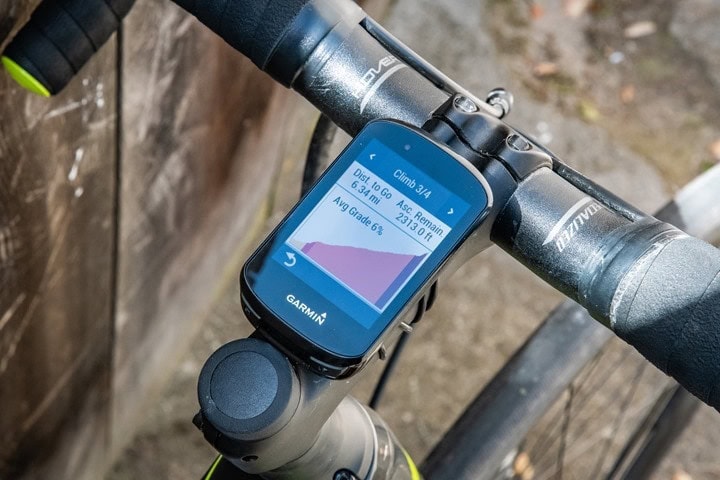
If you're looking for new Garmin cycling products – there's no bigger day than today. The company has just dropped three new products: The Edge 830 (this review), the less expensive Edge 530 (review here), and a set of new dual ANT+/Bluetooth Smart Speed & Cadence sensors (review coming up momentarily). While it'd be easy to assume the two new Edge units are merely incremental updates, the reality seems to be quite different. Sure, the user interface shares a number of similarities – but under the covers there's simply a boatload of new features.
The new units dive deep into both the road bike realm and mountain bike territory with new functions that I suspect both crowds will find useful. For mountain bikers there's new metrics to capture everything from how well you ride a downhill trail to how far your jumps are. Meanwhile, on-road riders will likely be more inclined to take advantage of the deeper training features and functions like heat and altitude acclimation tracking. But so many of the features cross-over between both camps that it's somewhat silly to try and definitively assign target audiences to all of them.
As always, I aim to detail the good, bad, and ugly about a given device. Note that this unit is a media loaner/test device and will very shortly go back to Garmin, like all other loaners. I do not accept any money (or even permit advertising) from any company I review. If you find this review useful, hit up the links at the end of the post to support the site.
If you're sitting here trying to determine how many cups of coffee you'll need to get through all three in-depth reviews, you'll find comfort in knowing that the Edge 530 and 830 are incredibly similar, with only a couple of unique features. So you can likely read one review fully, and then just skim the other one.
What's new:
Time to jump straight into all the newness on the Edge 830. And this time around I've got 18 new things on the Edge 830 (compared to the Edge 820 primarily), which outlines each of these features in as efficient a manner as I can possibly explain them – complete with pretty bike footage.
But if you're more of a metro-textual person, then I've put together the below list of words. Note that there are other tidbits that I probably haven't accounted for here – for example in certain menus or such where tiny things may have changed, but the below consolidates everything into one cohesive list of things you care about. For this listing I'm using the Edge 820 as the baseline for what's considered changed.
– Increased display size 13% from 2.3" to 2.6"
– Increased battery life from 15 to 20 hours, and to 48 hours in battery saver mode
– Significantly increased processor speed: Results in much faster route calculation (see videos)
– Added Garmin Heatmaps: This follows what Edge 1030 had, included in maps routing on unit
– Added ClimbPro: Automatically shows how much distance/elevation remains for each climb on route
– Added Mountain Bike Metrics: Shows Grit, Flow, and Jump details on both unit and Garmin Connect
– Added Trailforks maps to unit: Added global Trailforks data/maps to baked-in data on unit (no downloads required)
– Added ForkSight: Automatically shows mountain bike trail options when you pause at fork in trail
– Added Heat Acclimation: Will automatically take into account heat/humidity for performance/recovery metrics
– Added Altitude Acclimation: Will automatically take into account (high) elevation for performance/recovery metrics
– Added Training Plan API support: This includes a redesigned structured workout execution page
– Added Hydration/Nutrition Smart Alerts: When using a course/route, it'll automatically figure out how much water/calories you should be taking
– Added Hydration/Nutrition Tracking: It allows you to record this data in ride summary screens and log it on Garmin Connect
– Added Edge Battery Pack Support: You can now attach the Garmin integrated battery pack to the Edge (you can still use generic USB power too)
– Added Bluetooth Smart sensor support: You can now pair Bluetooth Smart sensors like heart rate, power, and cadence
– Added Performance Power Curve: This shows you your mean maximal power over different durations/time frames (like many training sites)
– Added Bike Alarm Feature: Used for cafes/bathroom stops, emits loud alarm if bike is moved
– Added 'Find my Edge' feature: Automatically record exact GPS location on your phone if Edge is disconnected (in case unit pops off)
– Added Training Plan Weather/Gear Tips: Basically tells you to HTFU when it's cold out
– Changed user interface bits: Tweaked user interface, which might take some people a few rides to get used to (or just myself)
Got all that? Good. Now usually I do include any 'negative' new things (such as features removed), but I haven't found any downsides to the new unit yet, or anything that's been removed. It's fairly rare for Garmin to remove features from unit to unit, though sometimes we see unintended consequences of other additions. Either way, I haven't found any of those yet in my riding (or asking lots of questions). Of course, that's separate from GPS/Altimeter/etc accuracy, which I cover in a separate section below.

So what are the key differences to the Edge 530 you might ask (since this costs $100 more)? No problem, here ya go:
– Edge 530 doesn't have a touchscreen
– Edge 530 can't do address-specific routing, whereas on the Edge 830 you can enter a street address
– Edge 530 doesn't have a searchable point of interest database (hotels/food/train stations/etc), though some of these POI's do appear on the map (but not as many in my experience)
– Edge 530 has four additional buttons on it since it has no touchscreen
Ultimately, it really comes down to the touchscreen, and then some user interface bits in using touch screen versus buttons. Feature-wise, the biggie is that the Edge 830 can route to a specific address whereas the Edge 530 you have to drag the cursor over that point. Both support pre-planned routes/courses equally. Personally, I'd struggle to remember even 2-3 times in the last 5-8 years where I've routed to a specific address or POI on the Edge series. Virtually everything I do is course or point driven.
With everything new and different all outlined, let's dive into actually using the darn thing.
Oh wait – one final thingy – a good thingy! Got an Edge 1030 already? You'll get almost every new feature you see above via firmware update to your Edge 1030. The only notable exception being that the pre-loaded mountain bike Trailforks maps are not there, due to licensing reasons (as Garmin licenses that from Trailforks). However, Garmin says the remaining features will show up in a firmware update over the coming months.
Size & Weight Comparisons:
Before we dive into all the details (or even the basics), let's just do a quick size check. Here's a disastrously big lineup of mostly current bike computers, all aligned on their base to a chunk of wood:

From left to right: Garmin Edge 130, Garmin Edge 520/520Plus/820 (identical case size), Polar M460, Wahoo BOLT, Garmin 530/830 (identical case size), Wahoo ELEMNT, Wahoo ELEMNT ROAM, Hammerhead Karoo, Garmin Edge 1030, Sigma ROX 12
The same order is below as well:

And then, just to zoom in on some of the more applicable units close up. Left to right: ELEMNT BOLT, Edge 530/830, ELEMNT, ELEMNT ROAM, and Hammerhead Karoo.
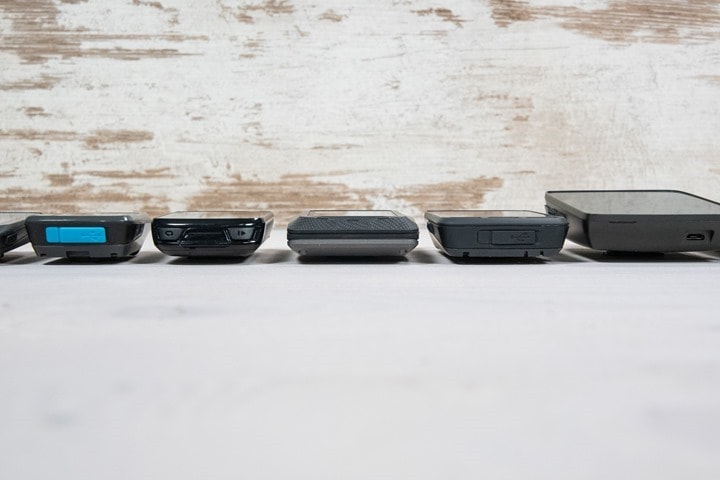
What's that? You want weights too?!? Ok, out with the trusty scale:
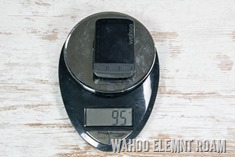
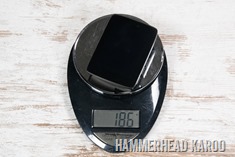
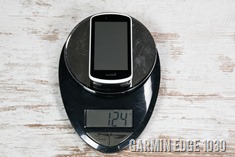
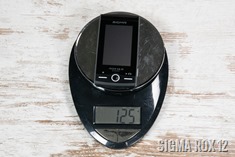

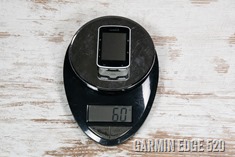
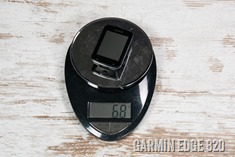
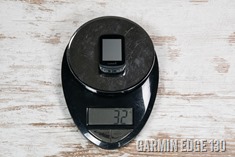

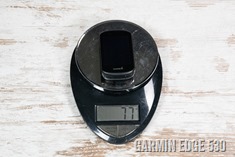
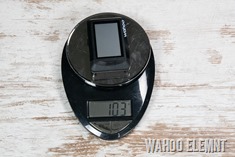
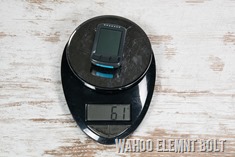
Ok, your Brady Bunch moment is over. Now for realz, let's get onto using it.
(Note: This comparison section was added after the Wahoo ROAM was released.)
The Basics:

First up I'll walk through all the basics of the device itself. If you're familiar with a Garmin Edge already, you'll find things haven't changed a ton here – depending on which version you're coming from. You're effectively seeing much of the user interface from the Edge 1030 brought down into this smaller form factor. In fact, I mostly struggle to find any reason to get the Edge 1030 now except larger screen size (which, is a perfectly fine reason).
On the Edge 830 you've got two main front buttons that are used for starting/stopping, and creating a lap. That's the only thing these buttons are used for – allowing you to always press them no matter what wonky corner of the menus you might be in.
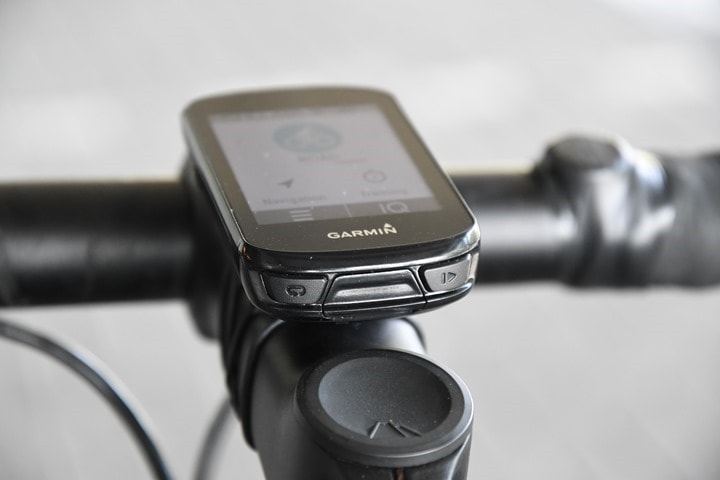
I know that some folks would have preferred Garmin shift these buttons to the top of the unit, since some out-front mounts make it a tight fit for gloves. Unfortunately, they remain in the same place as past units. Personally, I've never had any issues myself with that placement – but it seems to vary a lot on which mounts your using and in some cases your bike setup as well.
Next, on the left side you've got a single button, which is primarily used for powering on/off the unit.
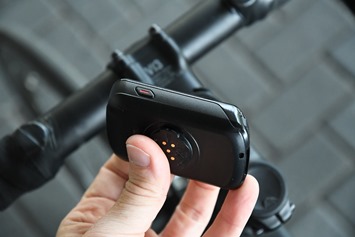
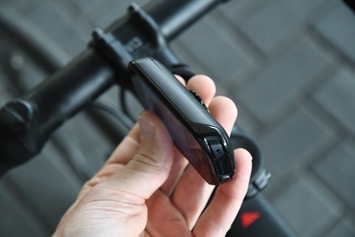
Of course, the screen itself is a full touchscreen. Garmin says they've learned from some of the troubles with the Edge 820 screen and that this should be improved, and indeed, I've had zero touch-screen specific issues on the Edge 830 (even in rain). Though, one has to keep in mind that the Edge 820 touchscreen issues were mostly manufacturing related, something Garmin solved over time (and even in earlier batches, it was unit to unit as to whether your unit was impacted). Still, with my sample size of two (which doesn't mean much), I haven't encountered anything in the last month (not a single instance of touch screen hell).
Back on the home menu, you'll find things are roughly divided up into three camps: Navigation, Training, and 'Everything else' (pressing those three little lines).

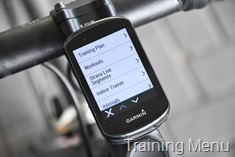

This is one area where Garmin has spent a bit of time sorting things, but there's still room for improvement. For example, the 'Training' section doesn't contain the new 'My Stats' section, which in turn contains all the actual training load related bits. As the meme goes 'You had one job!', and in this case, it would be to put the training stats in the training section.
In any event, if you swipe down from the top you'll get access to widgets as well as overall system status. This includes things like sensor status and GPS status. The Edge 830 joins the rest of Garmin's 2019 devices in using Sony GPS chipsets in lieu of previous MediaTek chipsets. The reason here being to significantly increase battery life, a change almost the entire sports tech industry has made in the last 12 months (Polar, Suunto, COROS, and undoubtedly others). But more on GPS accuracy a bit later on. In Garmin's implementation, they support both GPS+GLONASS as well as GPS+GALILEO, plus of course normal GPS. You can configure this differently on each activity profile you create/use.
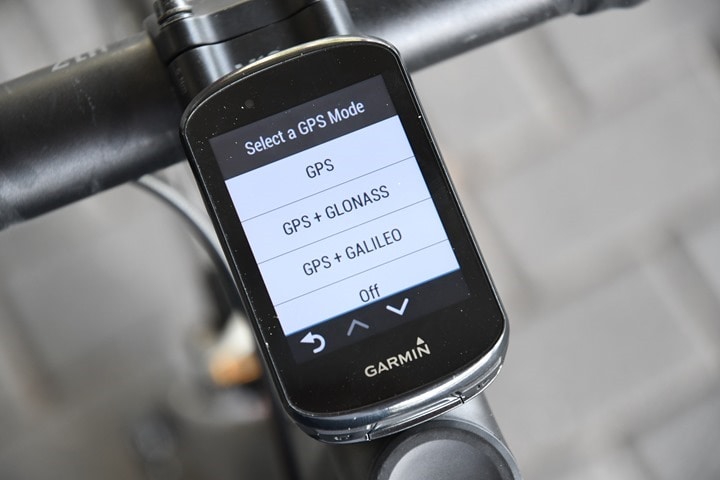
Speaking of activity profiles, these are used to customize settings for a particular type of riding. For example you might have one for road riding and another for mountain biking. Or yet another for racing that's slimmed down a bit. You can customize your various data pages in here, as well as automatic things like auto lap or alerts, plus nutrition/hydration info, Strava segment alerts, and so on. There's no practical limit to the number of custom data pages you can have, and you can have up to 12 data fields per page. Here's a sampler platter of some of the settings within a given activity profile (and you can make a boatload of profiles too):
I'm somewhat simplistic in that I've just got one for road ride, one for mountain biking, and one for racing. I never bother to delete the indoor one, but I also never use it either (it just automatically disables GPS).
As with all of Garmin's recent devices, activity profiles don't define sensors. Instead, those are done across the entire device and span all activity profiles. This is called the 'sensor pool', and basically means that you pair your sensor once to the device, and then it automatically connects to it when the sensor wakes up (such as spinning your wheel with a speed sensor on it, or spinning your crankset with a power meter on it). It works well, and continues to be the case here as well. The one major difference for the Edge 830 is that it supports Bluetooth Smart sensors (to match almost every other Garmin devices since 2017).
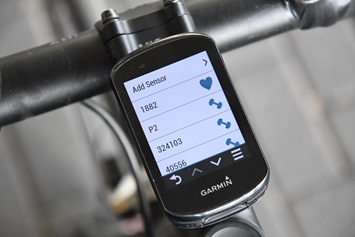
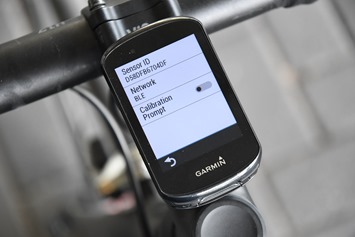
In total you can now pair all the following sensors on the Edge 830:
Cadence (ANT+ or Bluetooth Smart)
Edge Remote (ANT+)
eBike (ANT+)
Heart Rate (ANT+ or Bluetooth Smart)
Lights (ANT+)
Indoor Trainer (ANT+ FE-C, though paired in a different spot)
Radar (ANT+)
Power Meter (ANT+ or Bluetooth Smart)
Shifting (ANT+)
Shimano Di2 (ANT)
Speed/Cadence (ANT+ or Bluetooth Smart)
Speed (ANT+ or Bluetooth Smart)
Varia Vision (ANT+)
VIRB (ANT+)
Also, if you've got special sensors like aero sensors or tire pressure sensors, then individual Connect IQ apps can take care of those as well – adding even more craziness than you can log. In my case I've paired a blend of sensors, mostly ANT+ power meters/trainers, cadence sensors, speed sensors, and both ANT+ & Bluetooth Smart heart rate straps.
With everything all setup, you're ready to start riding. To do so simply tap the main 'Ride' button on the home screen, which gets you to your data pages where you can press the start button to start the ride (recording):
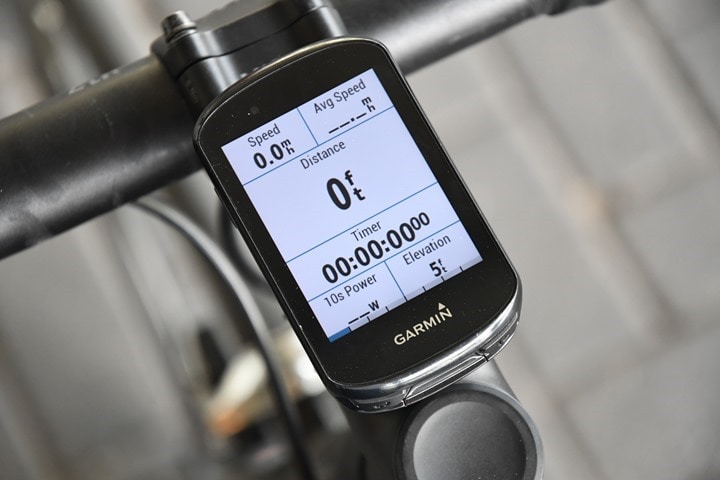
If you forget to press start, don't worry, the unit will warn you that you're moving but not recording (since it'll still show your data). But once it is recording you can swipe through the data pages using the touch screen (or auto-scroll if you want to do it automatically). Here's a quick collection of some of the screens:
You can also configure Live Tracking, which will share your location with friends/family/social media networks per whoever you've selected:
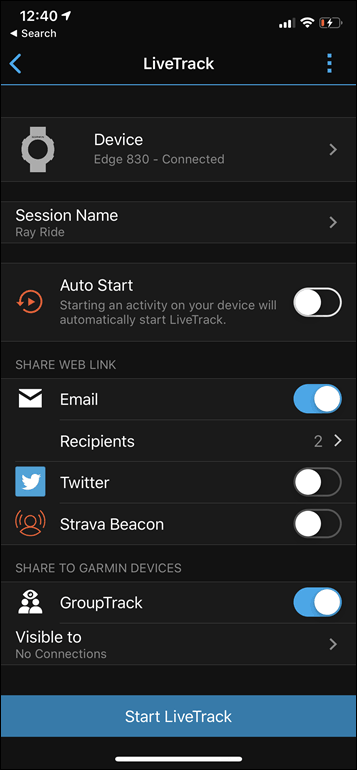
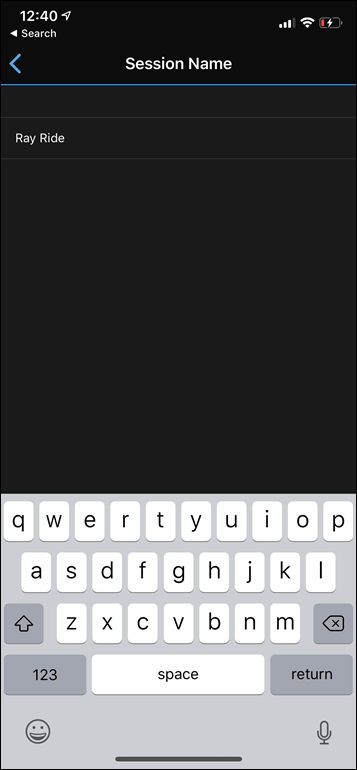
This is also leveraged for Group Tracking, which enables you to follow friends on a given group ride, and then send quick messages to those friends mid-ride. Regrettably, I lack any friends to test this feature out.
Note that there's also incident detection on both the Edge 530 and Edge 830, in case you crash. That doesn't depend on Live Tracking, but does depend on authorizing certain friends/family to receive notifications in case you crash. If it does trigger, you have a number of seconds to disable the notification (in the event of a false positive). I haven't had any false-positive events on either the Edge 530 or Edge 830 units.
To create manual laps you'll press the lower left 'lap' button, which in turn marks a manual lap for both the lap summary screen as well as in the file that Garmin Connect and 3rd party apps can access later, which is ideal for doing any sort of analysis.
Finally, once done you'll press the 'Stop' button on the right corner, which pauses the recording. Then press Save to save it. You'll then get ride summary data:
Once you've saved the ride it's near immediately synced via Bluetooth to your phone, as well as via WiFi if in range of WiFi networks that you've configured. The data is sent to Garmin Connect (online), and then onwards to any 3rd party platforms you've configured such as Strava, Xert or Training Peaks. You can also view the stats of your ride on the Garmin Connect Mobile app as well:
Or, you can view it on Garmin Connect (desktop/web) too. Here's one of my Edge 830 rides if you want to dig in further:
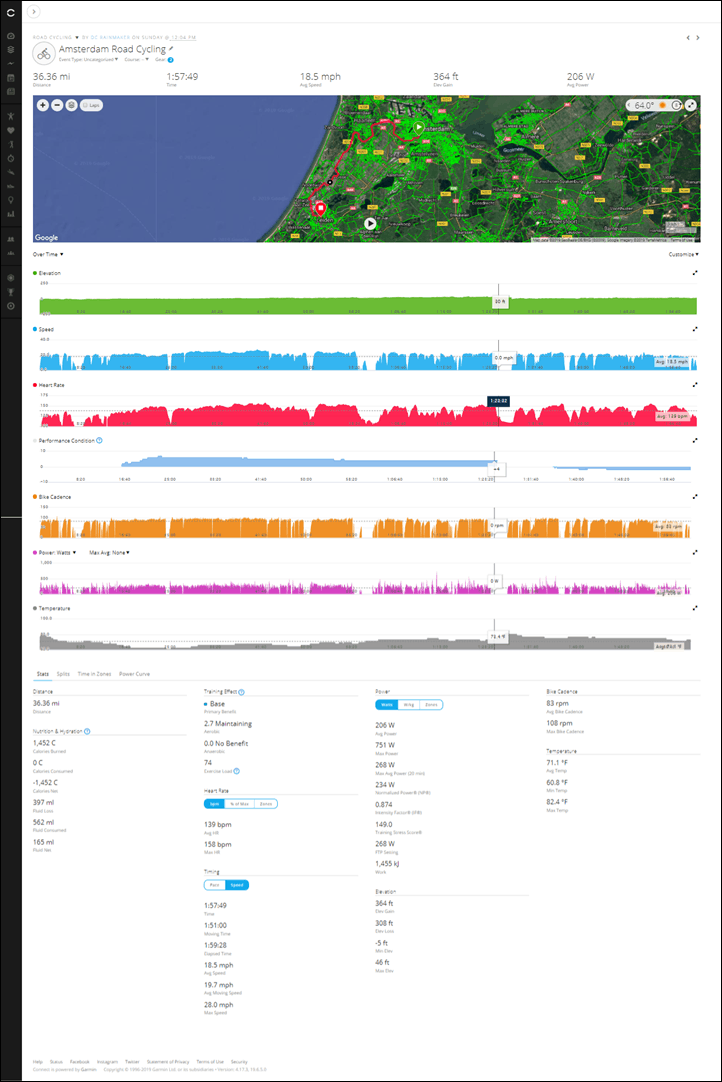
Lastly there's Garmin's new Bike Alarm feature. This is in addition to the 'Find my Edge' function that I talk about within the mountain biking section. But since we just finished a ride, I'll explain 'Bike Alarm' here, which is designed primarily for post-ride café settings, as well as parking your bike outside a bathroom somewhere. The goal being that you leave your Edge device on your bike and then if someone moves/touches it, it sounds an alarm. It uses the internal accelerometers to do so.
The setup for the feature is buried super deep in the menus. But once you've got it set up, you don't have to configure it each time. Instead, you'll access it from the widget menu up top, plus a few swipes depending on which widget page you started on. Personally, I actually prefer the Edge 530 method of just long-holding the left button. In any case, here's that menu on the Edge 830:
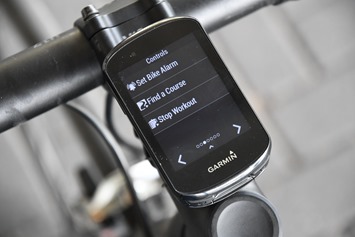
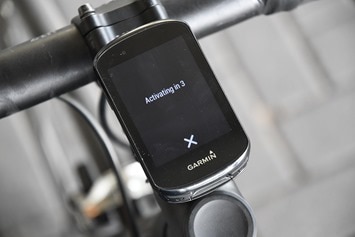
Once you've armed it, you'll get a 5-second count-down, and then it notifies you that it's armed. If you touch the bike, the alarm triggers, which…sounds hideous (in a good attention-drawing way).
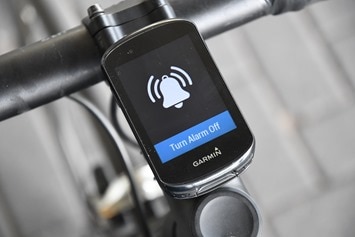
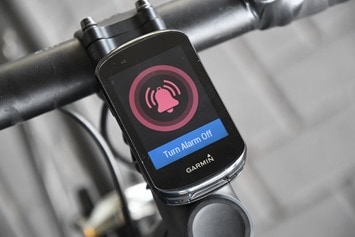
Additionally, if your phone is within range (and it probably is), you'll get a notification there which would also show up on any smartwatches you might have on. You'll get a notification when you arm it, when it's triggered, and when it's disarmed:
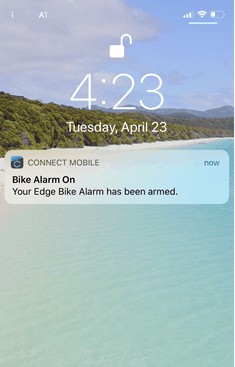
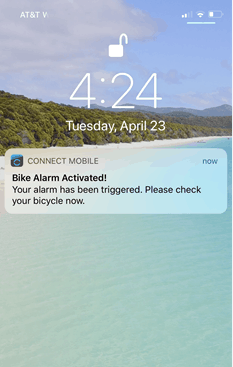
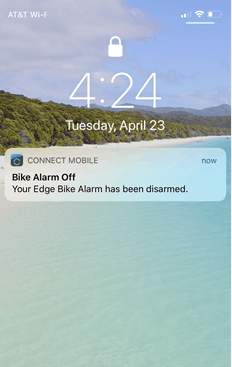
I demo the whole thing as part of the video up above in the 'What's new' section.
Admittedly when I first heard of the feature (without specific context on how to use it), I thought it was pretty stupid. But now that I've seen how it works and the exact use case, it actually makes a ton of sense. There's been countless times in the last 3-4 months (especially on group rides) where I'll stop at a café with my bike just barely visible. Given the goal is to enjoy being with friends, you might not always be paying attention. Between the audible alert and smartphone/watch notification – I would know immediately. Works great, I like it.
And at that point, we've got the basics covered and are ready to dive into all the cool newness – divided up into the various areas.
Mountain Bike Features:

It was a year ago that Garmin announced their partnership with Trailforks, primarily visible through a Connect IQ app that was preloaded on certain Garmin units. But anytime Garmin preloads Connect IQ apps on devices – it's a sign of a much deeper partnership. And the result of that becomes more clear with the new Edge 530/830. Not only is there deeper integration with Trailforks (substantially so), but also a pile of new metrics atop that.
Specifically, here's what' new:
Trailforks maps are baked into the Edge 830: This includes about 130,000 mountain bike trails, alongside trail ratings
Mountain Bike Dynamics: These metrics show how hard a trail was that you rode, as well as how well you rode it
ForkSight: This trail chooser screen automatically appears when you pause at a trail intersection
Find my Edge: While not absolute to mountain riding, this helps you find your bike computer if it flies off the mount on the trail
Trail Planning: You can ask the Edge to pick a trail of a certain rating, and it'll find you something to ride
You'll want to keep around the previous Trailforks Connect IQ app, since that has better tie-ins with your actual Trailforks account on their platform, so you can save your routes quickly and pull them into the Edge. So that's not going anywhere.
Let's start by talking metrics – of which three are basically three new ones – grouped under something called 'Mountain Bike Dynamics':
Grit: This calculates a difficulty score for each route, using elevation and GPS data. So kinda like a trail rating. If two riders ride the same exact trail, they should get the same Grit score. The higher the number the harder the course.
Flow: This is your specific rating for how well you rode the route. It's focused on the momentum of the ride, so things like braking impact hurt your score. A lower number is a better score. Thus, two riders could ride the exact same route and get totally different Flow scores.
Jumps: This will count how many jumps, and for each jump will include distance and hang time. Additionally, during the ride you'll get jump notifications in real-time with distance/hang time.
Looking at some of these in real-time, first we've got the jump metric. In my case, I suck at jumping (look, I'm a road cyclist/triathlete – you're just lucky I managed to ride a mountain bike at all). So while I got some jumps in my rides, my ability to capture those jumps while also taking a photo was not happening. So, here's a photo from Des that shows that:
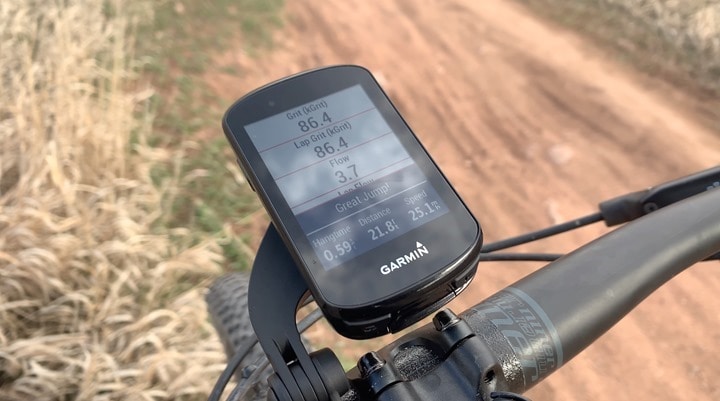
Next, there's the Grit and Flow scores, which you can add as data fields to your unit. Further, you can also see these as per-lap fields. So for example in downhill mountain biking if you created a lap at the top of each descent, you'd be able to see how these scores compared lap after lap.
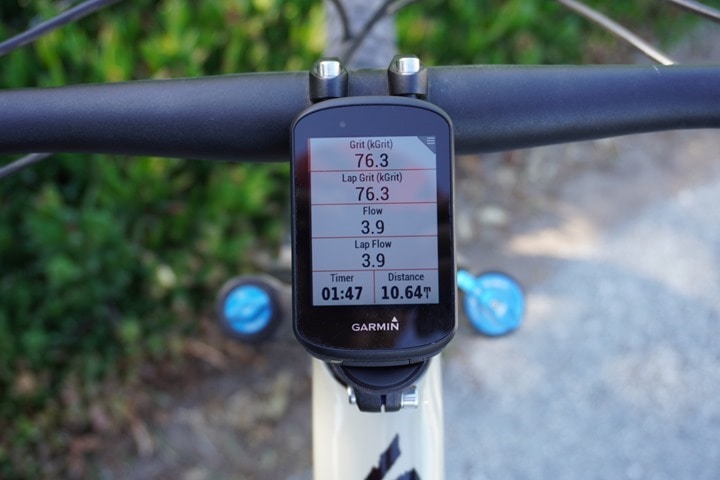
Afterwards, these scores show up on Garmin Connect (website). First, they actually show up on the map, color-coding your route – which is cool and something I wish Garmin did for other aspects of the map (like gradient % for road riding data).

Next, down below in the charts section they show up there too, also color coded:

And finally, down in the stats section you've got the new Mountain Bike Dynamics, including any jumps (or, lack thereof in my case):

You should be able to see these on Garmin Connect Mobile as well, though my app isn't showing them yet due to some bug, however, others that I know are seeing them just fine. So this appears to be a me-specific bug. The story of my life.
Next, there's the increased Trailforks integration. While Garmin hasn't quite bought out Trailforks yet, I'd be really surprised if we just don't see that happen. With the Edge 530/830 they've baked in all of the Trailforks trail data onto the unit itself. You will need to authorize that briefly the first time you use the unit, but it only takes a second. The existing Trailforks app is still there, since that takes care of better integration with Trailforks as a platform in terms of pulling your routes from your account and so-on.
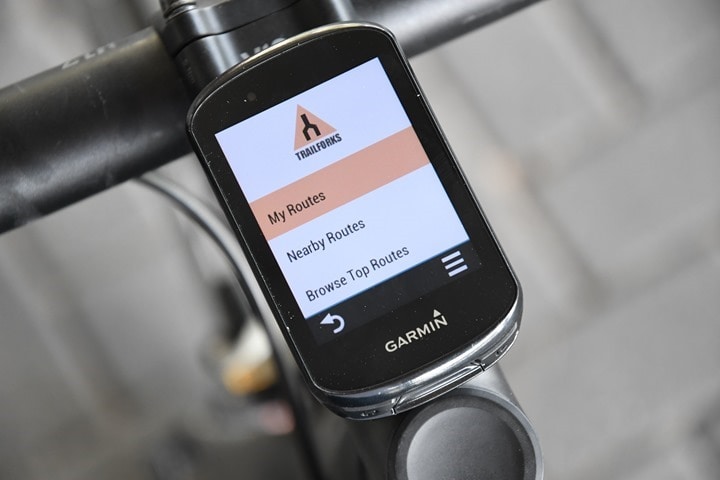
The most obvious way the new Trailforks data manifests itself is a feature called 'ForkSight', which automatically pops up anytime you pause at an intersection of trails (or, more appropriately – a fork in the trail). It's at this point it'll show you the trail options and difficulty grades/distances for each one:
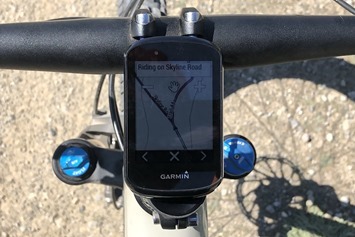
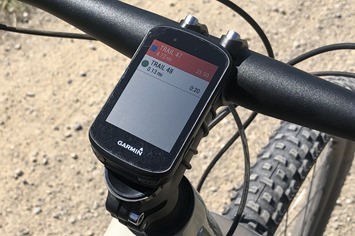
You can then select any of the options shown to get more information about that specific trail. It's super cool in real-life, and helps you figure out the implications of each option you have. That said, sometimes it can be a little confusing to figure out which trail is which if they aren't labeled at the trailhead. But for the most part you can figure it out.
Note: Above/below ForkSight photos on the Edge 530, since my Edge 830 somehow photos came out too fuzzy. It's identical functions, except that you use your finger to tap instead of the buttons.
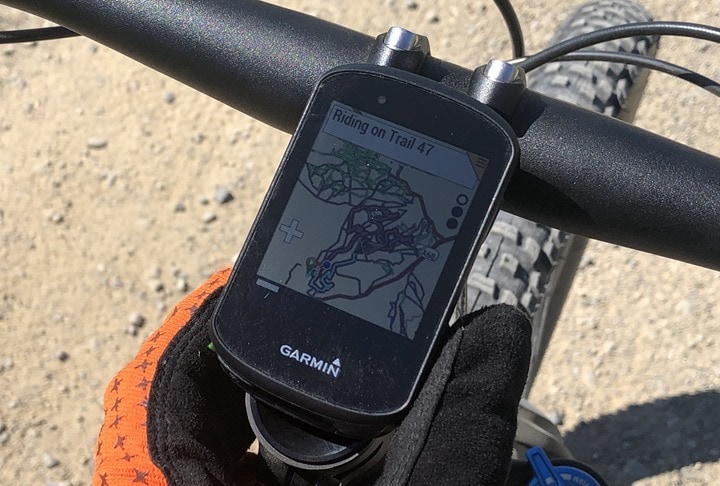
Next, there's 'Find my Edge', while not only for mountain biking, the reality is that most people will probably use it for mountain biking. This feature will instantly and automatically mark the exact GPS location where your unit disconnects from your phone (assuming the Garmin Connect Mobile app is on in the background). Then, on your phone you'll get an alert that allows you to open up the exact GPS coordinates with the mapping app of your choice (for example, the Google Maps app).
In addition, within the device options on Garmin Connect Mobile, it has two further options: 'Find my Edge' and 'Last Known Location'. If you select 'Last Known Location', it'll open up the default mapping app on your phone and then the exact GPS coordinates it last saw your Edge devices at:
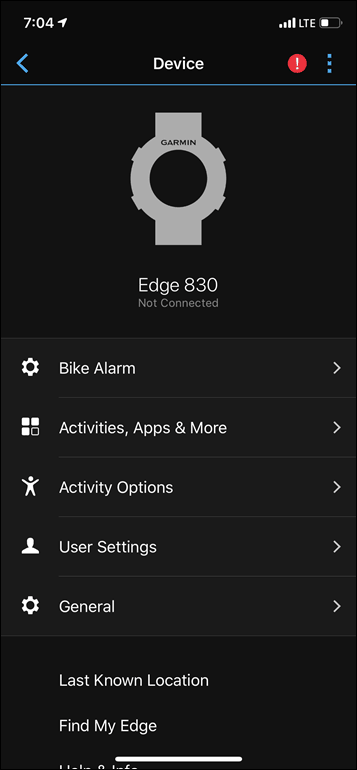

Whereas if you select 'Find my Edge', it'll try and connect to your Edge 830 and start an alarm sound. Which is basically just a constant beeper. It's not crazy loud, but loud enough that you should be able to find it. And here's what it looks like on the unit itself – saying 'Edge found'. The fact that it's on a map screen is just random coincidence. It'll show on whatever page you're on.
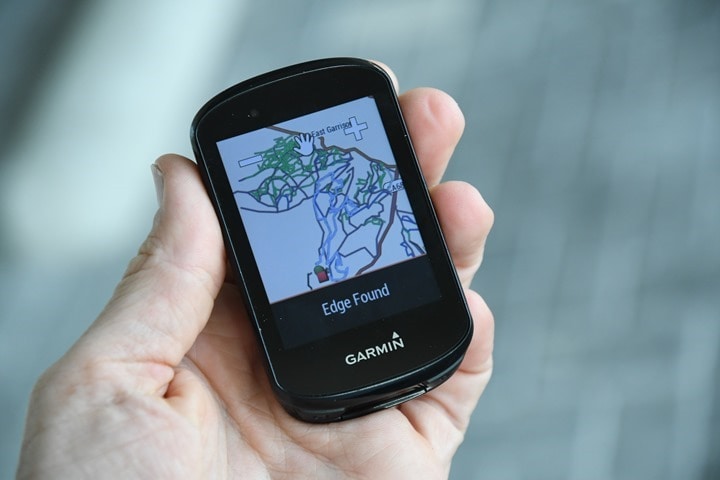
Note that this last little bit requires you be within Bluetooth Smart range. Outdoors that's roughly tens of meters, whereas indoors it's a crapshoot. Generally speaking though your GPS accuracy is within a few meters, so that gets you close enough to then use the beeper to find your Edge sitting in the bush. Roughly akin to how I found my GoPro mountain biking earlier this year..
Cool stuff, huh (especially my limited camera work)?
Oh, and as for the mountain bike bundle, in case you're looking at that, it comes with the following:
– Edge 830
– Mountain Bike Mount
– Silicone Case
– Edge Remote
– Dual ANT+/Bluetooth Smart Speed Sensor
While I've personally never bothered with the silicone case, if you're looking at picking up any of the other accessories, it probably makes sense to just get the bundle price-wise at that point.
Navigation:
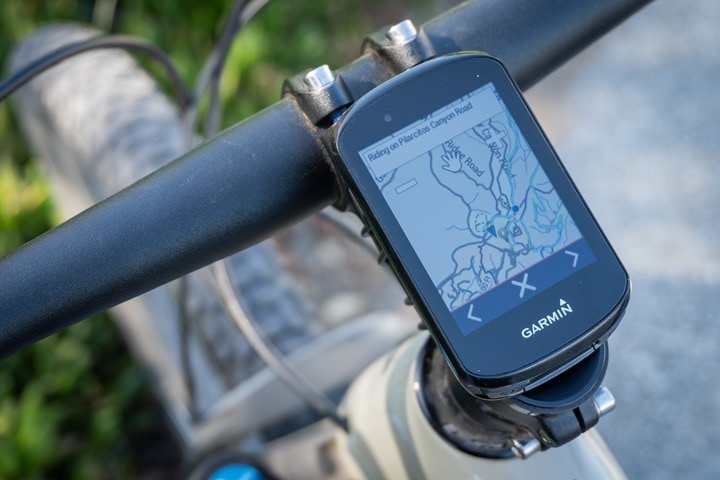
Like the Edge 820 before it, the Edge 830 contains a complete mapset for the region you bought it in. So if you've bought it in North America, then you'll get North American maps (but not European). However, unlike the Edge 820, the Edge 830 now adds popularity routing data to that mapset. That's basically their heat map data from Garmin Connect (and the hundreds of millions of activities there), the goal of which being to give you better routing data. most of the time, it works.
The key difference when it comes to navigation between the Edge 830 and the Edge 530 though is that the Edge 830 contains the ability to route to a specific address (I.e. 321 Main Street), whereas the Edge 530 doesn't. Further, the Edge 830 allows you to browser points of interest around you (such as restaurants, hotels, monuments), whereas the Edge 530 only shows a subset nearest you. And lastly, given the Edge 830 contains a touchscreen, you can navigate a bit faster through the map by just swiping/moving around.
But perhaps the most important feature on the entire new Edge 530/830 units is the significantly faster processor. I, alongside the entire internet have complained how darn slow Garmin's previous Edge series processors are. Which isn't to say I actually care about the processor specifically, but rather the end-resultant: Route calculation time. It would previously take numerous minutes for each just a short route to calculate. That was unacceptable, and thankfully, now it's a heck of a lot better. So much faster.
Now, there are slight differences depending on what exactly you're doing. I've found loading a saved route is the fastest of the bunch. So something like some 60KM routes from Strava that I've loaded are taking about just a few seconds depending on the locale. Whereas picking a point a distance away and letting it come up with a brand new route takes a few more seconds (like 10-20 seconds, not minutes). That's understandable since the first is just drawing a route, whereas the second is coming up with one. And yet it also seems to vary based on exactly where I am. Routes in Mallorca and California were silly quick (1-5 seconds), whereas here in crazy bike route density Amsterdam the routing takes a bit longer (5-15 seconds).
Now, again, there are three umbrella ways to route on the Edge 830:
1) Downloading a route (or opening a route file)
2) Routing to a specific point of interest or address
3) Just using the map to browse to a random cow field and route to it
I'll start first with just already having a predefined route (the most common thing I do). This can be something from Garmin Connect or a 3rd party site. It could be an individual route file you've downloaded, or it could be from a site like Strava via the Strava Routes Connect IQ app. In my case, I'm mostly using Strava routes (since I can use them on all my devices – acting like the Switzerland of routing). So we'll start there, grabbing that route from the pre-loaded Strava Routes CIQ app:

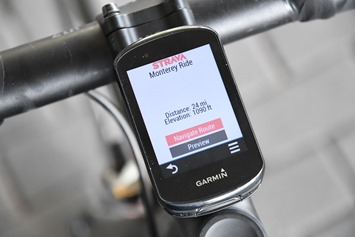
Next, it'll show me the route details:
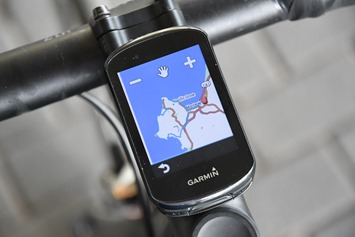
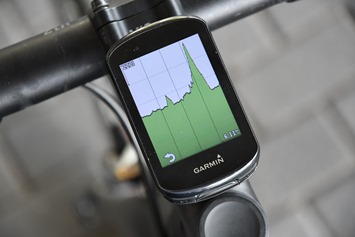
And finally, I can select to ride it. Within about 2-3 seconds, the route generation is complete and I'm ready to press start on my unit.
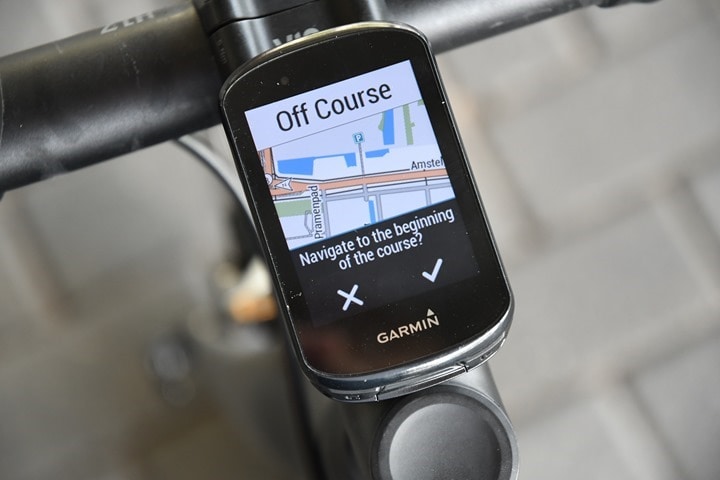
Now, when out on the road, I'll get turn by turn directions as I approach any turn. I've found these directions timely (unlike the Edge 520 Plus and sometimes the Edge 820), and in plenty of time to take action on them. Again, there does seem to be some slight variances in responsiveness based on where in the world I am, but none of the differences affected my ability to have boatloads of time.
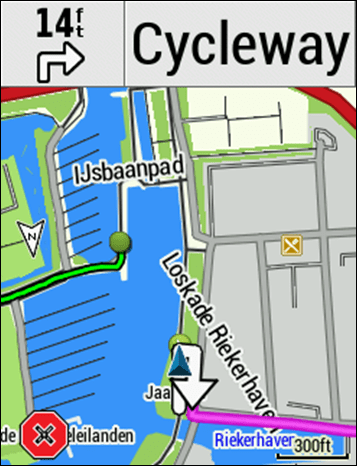
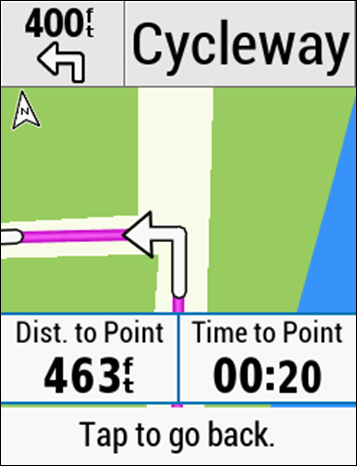
In addition, if I ignored a route, it'd automatically recalculate the route (including street names). Depending on the scenario, it'd either explain how to turn around and re-join the route, or in some cases cut a corner to catch-up down the road. I did however see one quirk in Amsterdam on a very short automatically generated route where it continued to try and go via some non-direct roads. After Garmin analyzed it they found a routing/mapping related bug that they say should be included in the next firmware update.
Note that the recalculation behavior is very different than that of a Wahoo BOLT/ELEMNT, which don't have a street-level map on them. Thus, they just point you back (compass-style) to the route itself, rather than giving you turn by turn directions. For many folks, that's perfectly fine, but I wanted to make that clear. Whereas the Garmin method matches that of Hammerhead's Karoo and Sigma's ROX 12 in terms of proper on-street routing data.
The next routing option is if you want to go to a specific address. You'll enter that in starting with the country, and then from there it depends on the exact country as to which data piece it asks for next. In my case in the Netherlands it asks for postal code next (since that actually gives you the exact street name too).

Meanwhile, if you want to route to a specific point of interest you can go to the POI's and choose something that looks interesting. Perhaps that's a nightclub, or BBQ. Though, based on my experience here in the last year – I've struggled with finding any BBQ place I'd recommend eating at. Bike shops yes, BBQ…no.
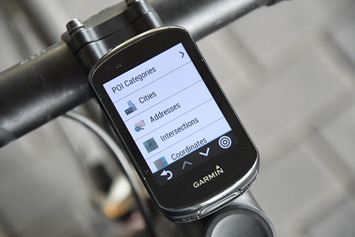

No matter what you end up choosing, the routing is the same. It'll simply calculate a route to that location and off you go. No interweb connectivity is required at any point here.
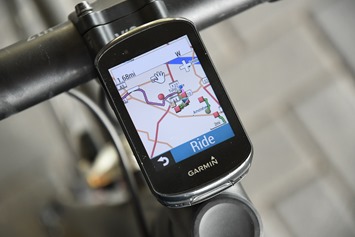
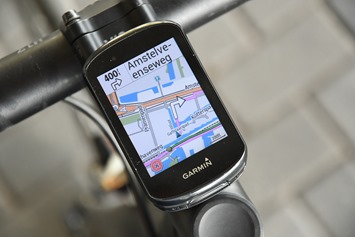
Next, what if you wanted to go somewhere unplanned? The Edge 830 can do that as well, you can simply pull open the 'Browse Map' option and then just stumble around using the touchscreen. You can zoom in/out, or just move the map around with your fingers. Once you've decided on a spot and selected it, it'll go off and calculate a route there.
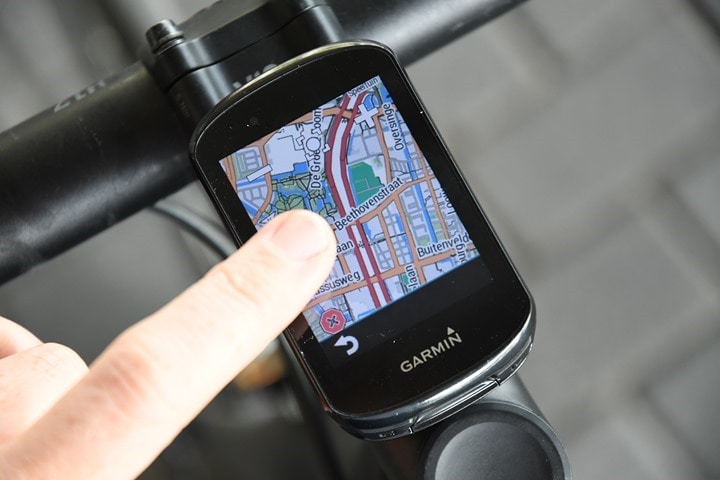
Again, the exact same as the other methods in terms of the 'getting there' part of routing – it all acts the same.
Finally, note that the unit in conjunction with your phone via the Garmin Connect Mobile app can also do some route planning. You can create round-trip routes whereby it goes and creates a route of a given distance for you automatically, as well as create manual routes connecting points together.
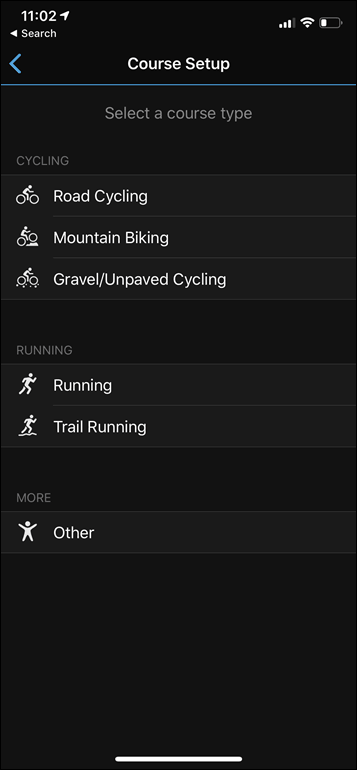
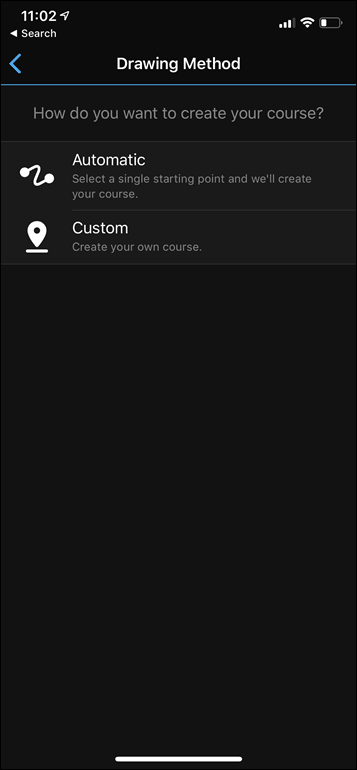
This new manual route creation bit is actually brand new – introduced in the last week or two (to everyone, not just Edge 530/830 peoples), and frankly, it sucks. I don't know how it could be so bad, but it really is. Having come from the Easy Route app world, where I just tappity-tap my way through a route, the Garmin Connect Mobile experience is just super clunky and imprecise, crazily zooming in and out like a drunk kid with a camera for the first time. Yes, you can get the job done, but it'll take you way longer.
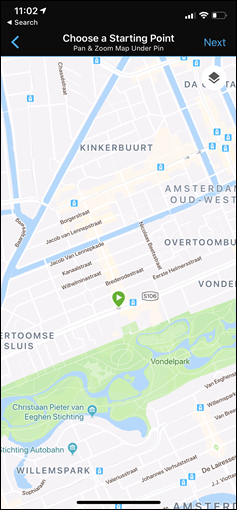
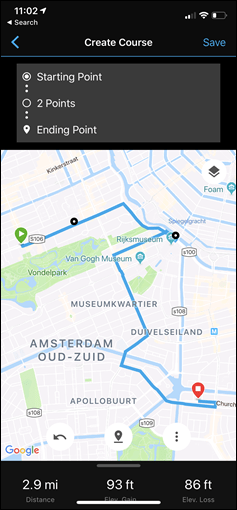
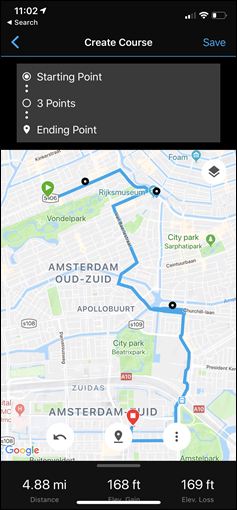
Hopefully though since it's a brand new feature it'll improve over time – maybe once someone buys a bulk pack of 40-grit sandpaper and goes to town on it.
Still, new app option aside – the rest of routing works great (finally). The processing time is what I'd expect from a unit of this price point, and the route calculation to match it. I know some folks still want phone-like speeds, but the reality is that this device is designed to last 20 hours (with screen-on, while connected to sensors and your phone), whereas a phone isn't. It's just two fundamentally different use cases with different processor choices and battery drain impacts.
That said, I would like to see Garmin integrate Strava routes directly though, as I find the Strava Routes app clunky compared to Wahoo's integrated Strava Routes capability. Also, I'd prefer to see Garmin allow easy loading of maps from other regions like Wahoo, rather than having to rely on 3rd party site downloads (or paying a bunch of cash).
Still, once you get the route/maps loaded, then Garmin's routing engine is leagues ahead of what Wahoo has. I suppose doing it for a decade longer will get you that experience.
Finally, note that if there's one thing I know about routing is that there are always edge cases in certain areas. In my case I've tested routing quite a bit in three core locations: Mallorca (Spain), Amsterdam (Netherlands), and Monterey (California, USA). This has included both on-road and off-road routes. However, there are always quirks in weird places that I might not have encountered, though for the most part the underlying mapping/routing data here should match that of the Edge 1030 – which people seem pretty happy with.
Training & Performance Metrics:
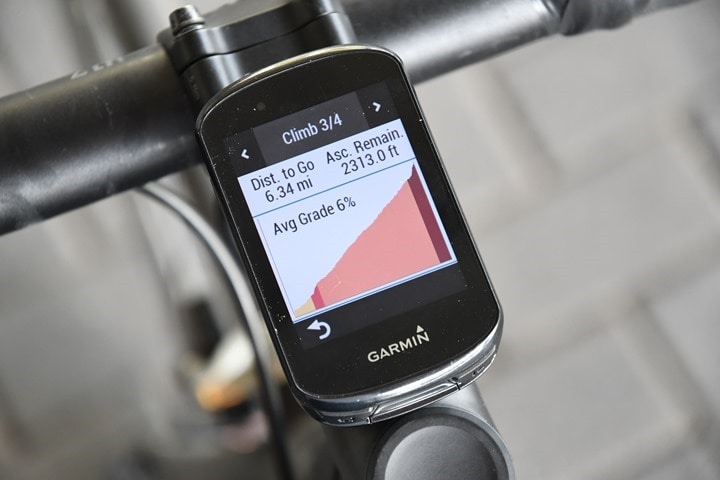
In many ways the Edge 530/830 launch has 'equalized' all of the training/load metrics across all of Garmin's higher end units. Previously there was one set for the Edge 1030, another for the Edge 820, and yet another for the Edge 520 Plus. And that's before we even factored in Fenix and Forerunner product lines. So consumers that used more than one device (like a Fenix 5 along with an Edge 820 for cycling), ended up with incontinent experiences. That should no longer be the case (at least going forward).
The Edge 830 (and the Edge 530) come with a slew of training and performance-related metrics, virtually all of which are new to this Edge price point (or in some cases Garmin products in general). And we're going to start with ClimbPro, which is hands-down my favorite feature on the Edge 530/830.
This feature automatically slices and dices your planned routes climbs, and generates detailed climb charts for each climb as you ride them. The feature actually originated from the Fenix 5 Plus wearables last year, but really shines here on the larger screen of the Edge series as a cycling focused function. It requires that you have some route/course loaded, so it knows where you're going. Once you've got that, you can see the list of climbs within the ClimbPro summary screen on the route planning page:

Then while you're riding it'll automatically show the ClimbPro page for each climb once you enter it. Kinda like Strava Segments for climbs, minus the racing aspect. The climb page shows the distance remaining on the climb, the ascent remaining, the average grade remaining, and then two customizable fields at the bottom. By default, these are heading and elevation, but you can change them as you see fit.
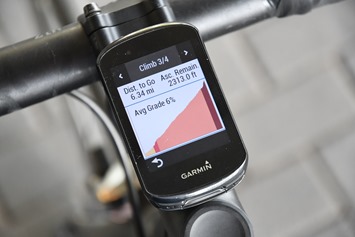
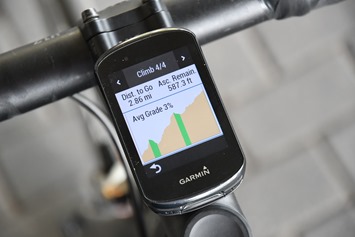
The Edge 830 will color-code the pain of the climb segments on the ClimbPro page based on gradient as seen above. These are bucketed into:
0-3%: Green
3-6%: Yellow
6-9%: Orange
9-12%: Red
12%+: Please make it stop dark red
Having ridden with this feature last month on Mallorca it was super cool. Not only for major climbs like Sa Calobra, but actually for some of the smaller ones before and after it. For example, after you finish the famed Sa Calobra and continue out of that area you've actually still got another minor climb to do before you descend one of a few routes back to the remainder of the island. Having ClimbPro on my screen was super handy to know how much suck was left, since mentally you sorta forgot about these minor climbs you've still gotta do in comparison to the big one you just knocked out.
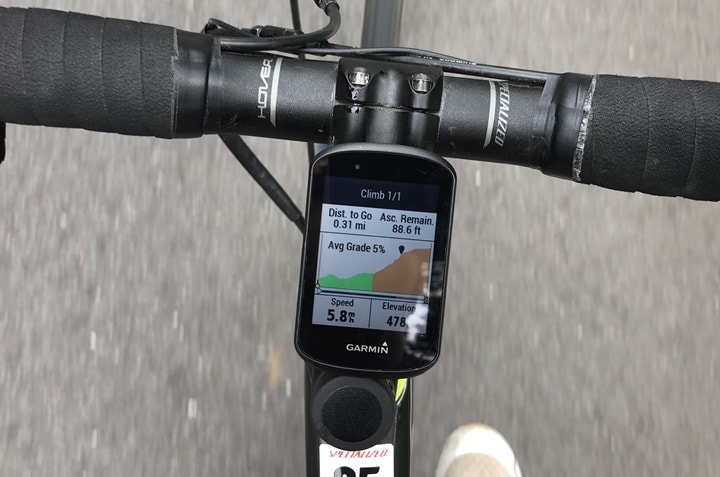
Even on the hills around Sea Otter two weeks ago while mountain biking it was handy for some of the shorter but also painful routes. And again, what's cool is that this will show up anytime you load up a course or trail, automatically (no interwebs required).
Garmin notes that they expect to tweak the definition of a climb based on feedback over the next month or two. Specifically, whether or not something triggers a climb on ClimbPro (since this is calculated on the unit itself when a route is loaded). Obviously, there's no international definition when it comes to what's a cycling climb and what's not. Still, the definition they're using as of today is as follows:
Total value must be 3,500 or higher where: Distance of climb in meters (min 500 meters) * Gradient (min average 3%)
So, doing some samples here to help understand:
Climb A: 1,000 meters long at 4% = 1,000*4 = 4,000: Yes, qualifies as a climb
Climb B: 5,000 meters long at 2% = 5,000*2 = 10,000: No, doesn't meet 3% threshold
Climb C: 500 meters long at 8% = 500*8 = 4,000: Yes, qualifies as a climb
Make sense? Again, simply calculate distance in meters by incline/gradient and see if it's above 3,500. Also, ensure average gradient is 3%. As I said above – I think it's probably the coolest feature on the Edge 530/830.
Next, speaking of elevation, there's two new features coupled together – heat and altitude acclimation. Both of these are actually quietly present on the Garmin MARQ series as well. The goal behind both of these are post-workout calculations tied to figuring out whether or not you're acclimated to a given temperature or altitude. Obviously, both can significantly impact performance. Starting with heat acclimation, the function leverages nearby weather stations. So your unit has to have connected to Garmin Connect Mobile within 3 hours of starting your ride in order to receive that weather data (it doesn't use on-device temperature).
Then, for heat acclimation it applies a heat correction factor for rides above 71°F/22°C, using a percentage based amount from published studies (humidity is also factored into this as well). This is then shown in the training status widget. Garmin says they assume full acclimation takes a minimum of 4 days, and acclimation/adaptation to a given high temperature will automatically decay after 3 days of skipped training within that heat levels.
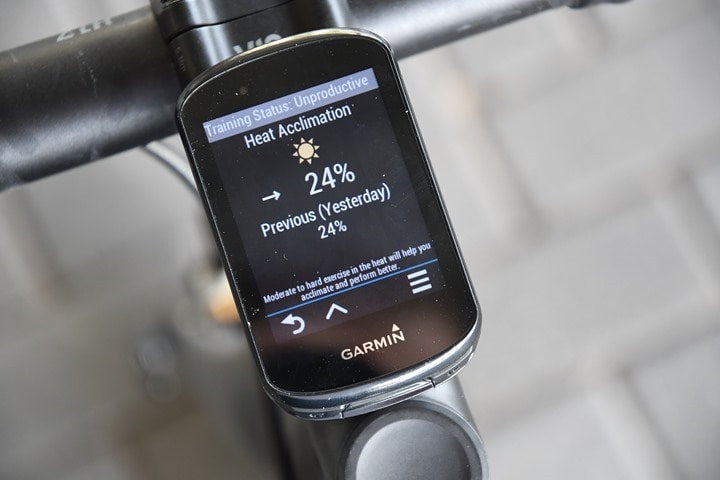
Altitude acclimation/adaption is roughly similar (also seen above). The minimum threshold is at altitudes above 850m/2,788ft, and tops out at 4,000m/13,123ft (Garmin doesn't calculate above that for cycling, sorry folks). Garmin says that they divide up training vs living altitudes, just as typical studies would. The company says that adaptation algorithms within the Edge 530/830 assume total adaptation after 21 days, and that adaptation is faster at the beginning of altitude exposure. Additionally, adaptation will decay within 21-28 days depending on acclimation level. Because I haven't had any high altitude rides lately, I'm deferring you to Mr. DesFit, who has, and kindly lent me his high altitude shot:
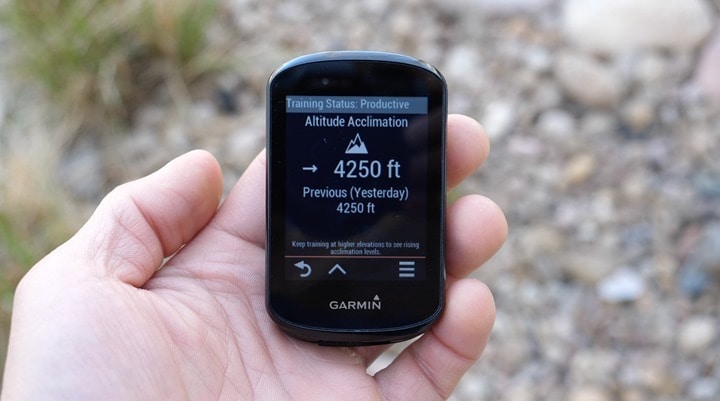
What the feature shows is your current altitude adaptation level. In other words, if I go from living at sea level (as I do) to moving to the French Alps, each day it'll show what my body has acclimated to. This essentially automates/charts the exact same process that many elite athletes take when preparing for races. In fact, a pro triathlete friend of mine wrote a guest post here on that very topic some 8 years ago. For the rest of us, we can just use this as a post-ride pub excuse for why we climbed so poorly on our week-long vacation in the Alps. Obviously, we weren't acclimated.
Also of note is that if the Edge 530/830 are put into 'sleep' mode (as opposed to powered full off), it'll actually do a check each night at midnight of where it is altitude wise, and account for that – just like the MARQ series watch does every night at midnight. Effectively giving you credit for sleeping at high altitude.
Next, there's new hydration/nutrition alerts and record keeping. These alerts will appear mid-ride anytime you've loaded a pre-planned course/route into the Edge, and are based on your profile (gender/weight). Effectively, it's trying to help you remember to eat and drink – a chronic problem for most longer-distance cyclists and triathletes. Or, at least me. These alerts automatically show up seemingly based on caloric intake variables, and will give you Garmin's recommendations for fluid and calories, impacted by the current temperature/humidity as well. Garmin did note that these are capped though to account for maximum hydration intake limits of the human body.
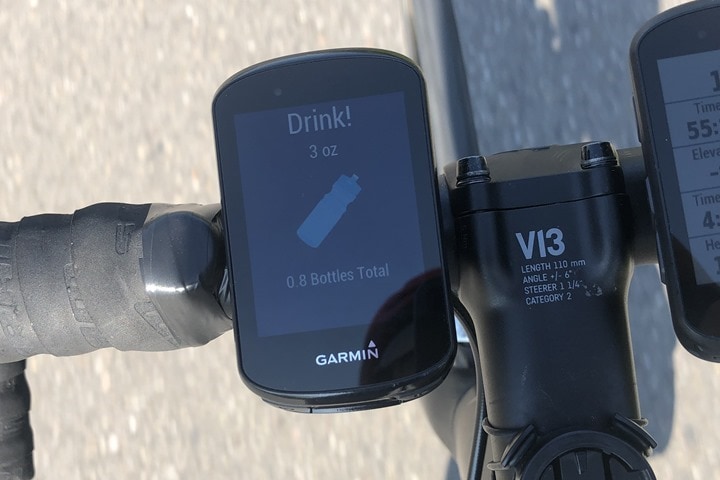
In other words, they know that in some super hot/humid scenarios you could lose more hydration than you could possibly consume/absorb in the same timeframe, so they shouldn't be giving you crazy recommendations like drinking three full bottles per hour. I haven't hit that kinda weather yet, so it's hard to tell for sure.
Then, afterwards you've got new hydration/nutrition tracking These pages are shown for any rides longer than 90 minutes, where it'll ask you how much you drank and ate. It's here over the last few months that I've realized the answer is always 'not enough'.
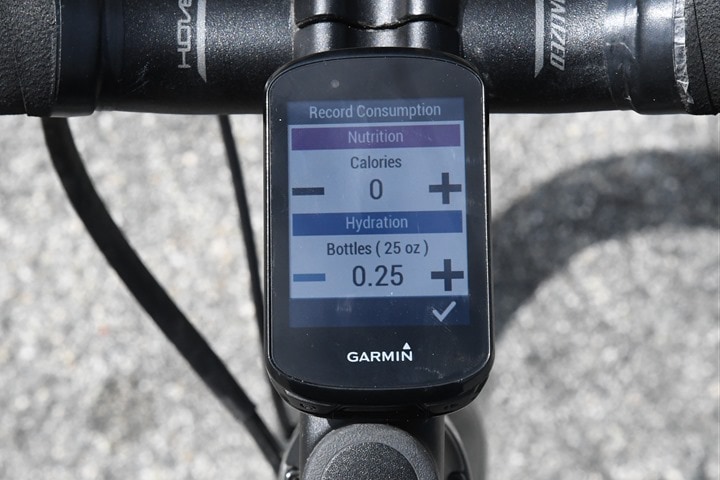
This data is then shown on Garmin Connect (but oddly not Garmin Connect Mobile):

In addition to the post-ride nutrition stats, there's your total training status stats. These stats are a step above what you've historically gotten on the Edge series, and are in line to match that of MARQ (and a step above the Fenix 5 Plus). Note that some of these stats require a power meter (like FTP). Here's the overview 'My Stats' page (though, much of this is also shown post-ride on the summary screens):

First, there's Training Status, which is showing you Training Load over the last 7 days. Note that this includes non-riding activities as well, if they've synced from other Garmin wearable devices.
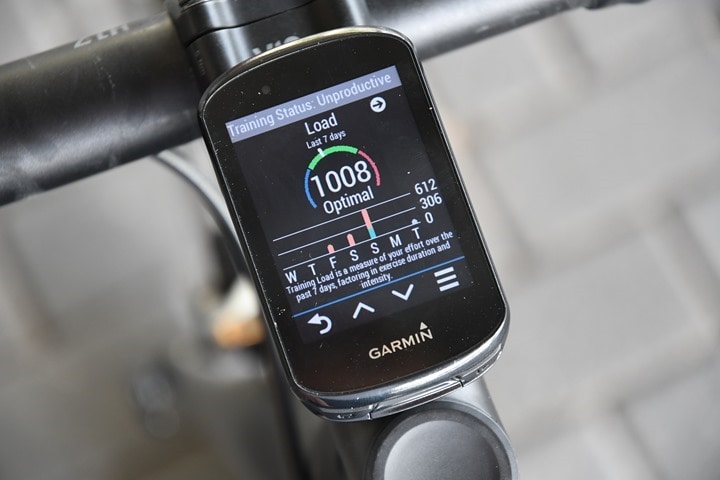
Next, there's Training Load Focus, which is showing you the breakouts of your training types over the last four weeks. It then shows you in the dotted line the optimal (aka balanced) training load bucketing. Obviously, I ignore anything that's optimal or balanced.
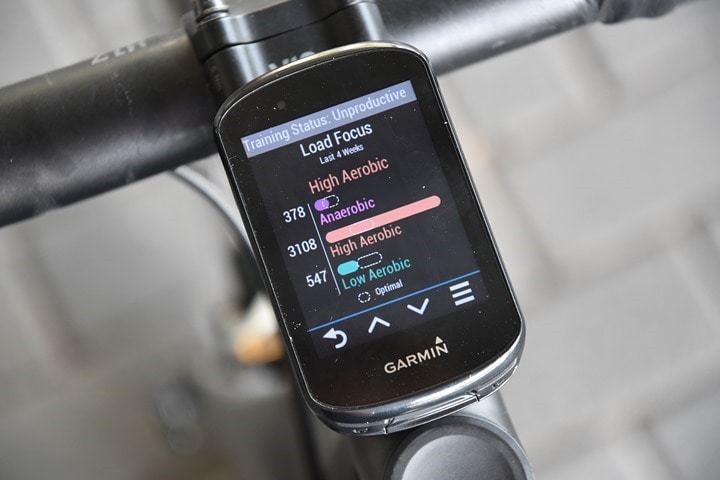
Then there's Recovery Time, which is load-based and includes time from other devices as well. This is telling you how many hours you should wait until your next hard workout:
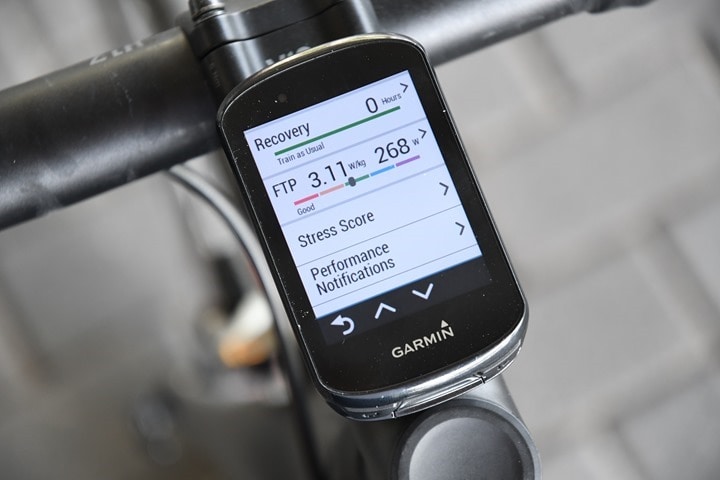
After that there's VO2Max and FTP, both of which are calculated (FTP calculation requires a power meter). And finally, one of the newer metrics not seen on any other Garmin device is Power Curve. This is basically just a mean-max power graph, and loosely mirrors what we've had on various training platforms for more than a decade.
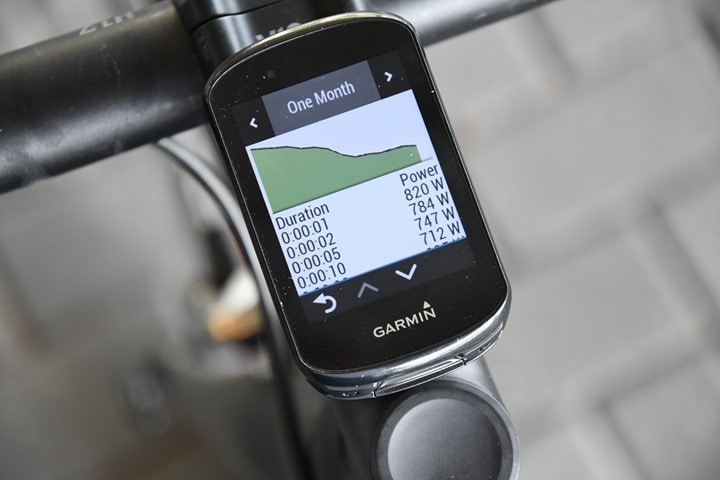
The time duration is selectable as three choices – one month, three months, and twelve months. It does appear to pull in data from Garmin Connect as well, which is a good thing and shows tighter integration there than we've previously seen for Personal Records on other Garmin devices. On the downside, if you've got bad power meter data mixed in there (as I do apparently), it skews some of the numbers.
Last but not least, there's on-device training plans. You could previously see all of this on Garmin Connect, but it wasn't super visible on the Edge itself. Now, if you've got a training plan loaded (including those from TrainingPeaks and soon also TrainerRoad), those will appear here. This also applies to the host of free training plans that Garmin has on Garmin Connect.

Once you load a workout up, you'll get similar step by step instructions on the Edge as before, but now with a bit better overview metrics and showing exactly how that workout should look:
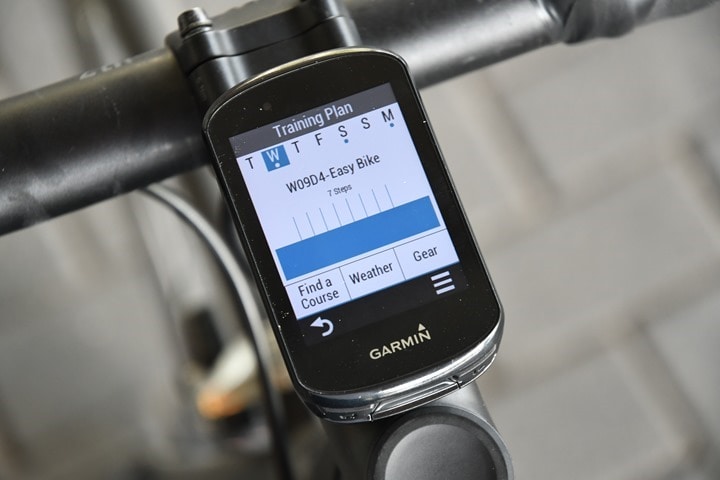
Additionally, there's now a new 'Gear' and 'Weather' option. The weather simply shows the weather for that day of the week that the workout is scheduled. Whereas the gear option aims to give you tips on what kind of gear you should have that day (for example, if it's cold and miserable to bring gloves). Garmin says that they're trying to provide tips for cyclists that may not be as experienced. The rest of us know that it's simply better to stay indoors and Zwift instead.
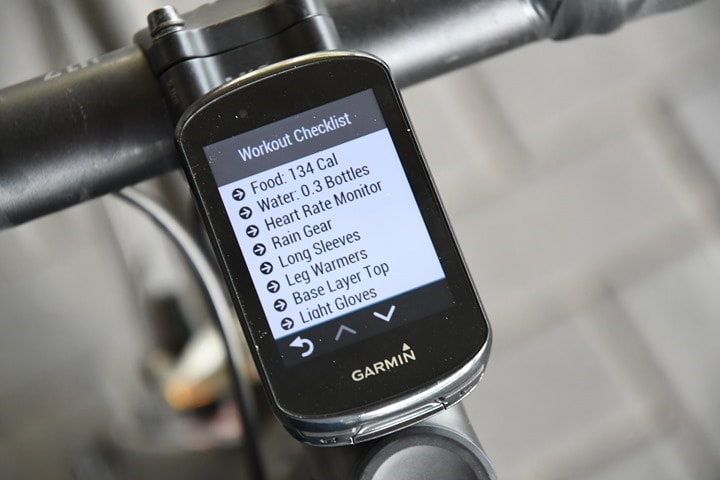
As usual, once you've completed these workouts, they'll sync up to Garmin Connect and the various 3rd party platforms they might have come from.
Ultimately, the goal behind all these metrics is that they're across the board with your other Garmin devices. So if you've got a Garmin wearable that supports these metrics (or some portion of them), then everything should match. Understanding that I'm a bit of an edge case due to how many Garmin devices I'm using at once for testing, that concept roughly pans out – though there's still some cracks here and there where physiological data from one device doesn't match another. Still, for the normal person that doesn't ride with 12 devices at once, it's nice to see some of this glue finally hardening.
GPS & Elevation Accuracy:

There's likely no topic that stirs as much discussion and passion as GPS accuracy. A watch could fall apart and give you dire electrical shocks while doing so, but if it shows you on the wrong side of the road? Oh hell no, bring on the fury of the internet!
GPS accuracy can be looked at in a number of different ways, but I prefer to look at it using a number of devices in real-world scenarios across a vast number of activities. I use 2-6 other devices at once, trying to get a clear picture of how a given set of devices handles conditions on a certain day. Conditions include everything from tree/building cover to weather.
Over the years I've continued to tweak my GPS testing methodology. For example, for watches I try to not place two units next to each other on my wrists, as that can impact signal. If I do so, I'll put a thin fabric spacer of about 1"/3cm between them (I didn't do that for any workouts here). But often I'll simply carry other units by the straps, or attach them to the shoulder straps of my hydration backpack. Plus, wearing multiple watches on the same wrist is well known to impact optical HR accuracy. For cycling units, I arrange them on my handlebars using standard mounts – usually one on either side of the step, often a bit separated from each other.
Next, as noted, I use just my daily training routes. Using a single route over and over again isn't really indicative of real-world conditions, it's just indicative of one trail. The workouts you see here are just my normal daily workouts. I've had a fair bit of variety of terrain within the time period of testing Garmin Edge units. This has included workouts in: Amsterdam (city, countryside) and Mallorca (mountains, ocean, countryside), California (off-road, hills, forests, seaside).
We're gonna look at a few different rides in different parts of the world. First, we'll start with the famed Sa Calobra in Mallorca. I rode this nearly a month ago, so while this firmware was slightly older, it still shows pretty solid GPS performance. Here is the data set compared to the Garmin MARQ watch and the Samsung Galaxy Watch Active.
![image_thumb[32] image_thumb[32]](https://media.dcrainmaker.com/images/2019/04/image_thumb32_thumb-1.png)
This super twisty-turny route is incredibly difficult from a GPS performance standpoint. There are rock tunnels, huge cliffs next to you, and plenty of GPS-blocking goodness to hose up units (as we see the Samsung illustrate).
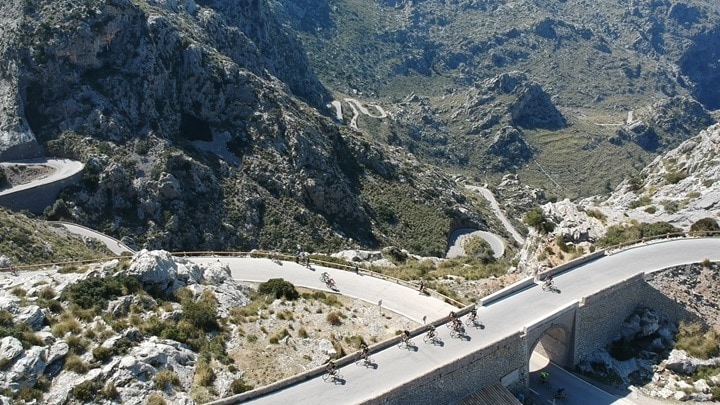
I'm going to zoom into one of the more difficult points here:
![image_thumb[35] image_thumb[35]](https://media.dcrainmaker.com/images/2019/04/image_thumb35_thumb-1.png)
Of course, with the trees it's hard to see what's going on. But I just wanted to show you first the density of trees. In fact, you can see the Samsung straight-up gave up on life half-way through this and just cut the corner entirely. So we'll ignore it.
![image_thumb[36] image_thumb[36]](https://media.dcrainmaker.com/images/2019/04/image_thumb36_thumb-1.png)
The other units tracks are actually very close. There's a few bottles of the Garmin MARQ at one point where the cave is (the green text you see). That's this thing:
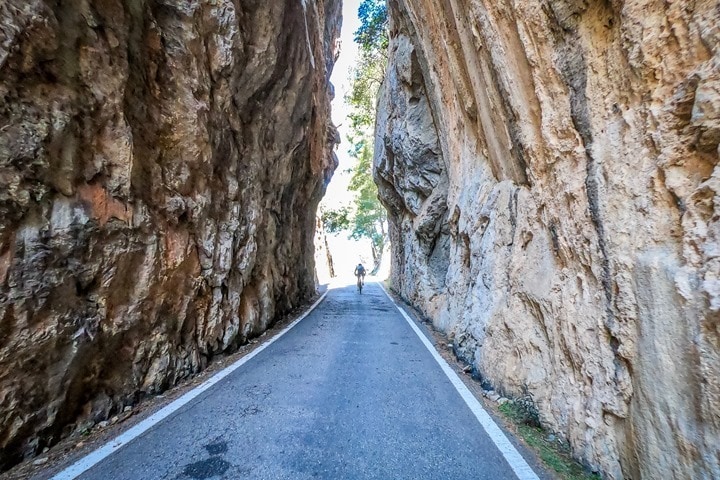
But most importantly, the two Edge 530/830 units tracked through that just fine and dandy. Perhaps by skill, or perhaps by dumb luck. They did it both directions though.
Now I had a quick lunch at the bottom before heading up. GPS-wise, units were fine here. I left them recording on my bike while I ate.
![image_thumb[38] image_thumb[38]](https://media.dcrainmaker.com/images/2019/04/image_thumb38_thumb-1.png)
Though I did see some elevation issues here were it showed me quite a bit higher in elevation than I really was (300ft higher than the sea I was sitting next to). Garmin isn't super clear on why this happened, though I haven't seen it happen again. And again, that was a month ago on older firmware.
And in fact, if we look at route elevation for the next day, you'll see the two Edge 530/830 units nail the elevation without any issues, super clean and consistent. The Samsung…is…well…yeah.
![image_thumb[40] image_thumb[40]](https://media.dcrainmaker.com/images/2019/04/image_thumb40_thumb-1.png)
Next we've got a ride in Monterey, California from two weeks ago. This was a nice coastal ride that also went through some gigantic tree forests. Plus it had a couple of rollers and a solid climb mid-way through. For this, I've got both Edge 530/830 units, as well as the Garmin MARQ watch and the Polar Vantage V GPS watch. Here's the high-level overview of the GPS from that set:
![image_thumb[17] image_thumb[17]](https://media.dcrainmaker.com/images/2019/04/image_thumb17_thumb-1.png)
We'll go ahead and zoom into some sections, starting with early on. It's here we see the Edge 530 is a bit offset from the rest. Why you ask? It was in my back jersey pocket. I needed to photograph the Edge 830 solo-cup:
![image_thumb[19] image_thumb[19]](https://media.dcrainmaker.com/images/2019/04/image_thumb19_thumb-1.png)
However, once we turned the corner I then got it on my handlebars and it was clean sailing:
![image_thumb[21] image_thumb[21]](https://media.dcrainmaker.com/images/2019/04/image_thumb21_thumb-1.png)
I know, it's hard to see the lines above. But how could I not go to satellite view with scenery like that? Ok, I'll go back to boring map view for the next ones.
Oh, back in the pocket it went for a climb to get other photos. Why bother including this you ask? Well two reason. First, in case you're browsing the files and wondering why it went all sideways, and second, because I actually see a surprising number of people that stick GPS devices in their back pockets. This shows you what can happen.
![image_thumb[23] image_thumb[23]](https://media.dcrainmaker.com/images/2019/04/image_thumb23_thumb-1.png)
This is back in the forests and back on the handlebars:
![image_thumb[26] image_thumb[26]](https://media.dcrainmaker.com/images/2019/04/image_thumb26_thumb-1.png)
It was at least pretty consistent in that when it went into my pocket it went a bit sideways. This ride unfortunately had a lot of that, as we were filming other videos for things that were published prior to this review (and thus prior to this embargo). Though interestingly the Edge 830 seemed to handle the pocketing better than the Edge 530 on this ride. No idea why.
Here's another section with all of them out – nice and clean. And this is actually in the trees a fair bit alongside a highway.
![image_thumb[28] image_thumb[28]](https://media.dcrainmaker.com/images/2019/04/image_thumb28_thumb-1.png)
As for altitude? Pretty similar overall, however the Edge 830 did seem offset about 18 meters throughout the entire ride. I suspect it got a weird initial fix which is used to then calibrate the barometer.
![image_thumb[30] image_thumb[30]](https://media.dcrainmaker.com/images/2019/04/image_thumb30_thumb-1.png)
As for the couple of spikes in there – I haven't seen those on any other rides, and thus I suspect that's due to the pocketing. I didn't see it on numerous rides in Mallorca on legit climbs, nor any mountain bike rides elsewhere in California.
Next, we've got a ride I did this past weekend from Amsterdam one-way, down south through the Tulip fields. For this ride I've got it compared against the Polar Vantage V GPS watch, as well as actually also have the new magnetless speed sensor in fully standalone mode (meaning, it was just recording to itself). You won't see a GPS track from the standalone sensor, but it does show us speed and distance. Here's what things looked like in that data set:
![image_thumb[1] image_thumb[1]](https://media.dcrainmaker.com/images/2019/04/image_thumb1_thumb-1.png)
Ok, at a high level that's pretty boring. Nobody does anything stupid, so all the tracks look fine from 30,000ft. Let's zoom in a bunch to some corners and such. Note that all of these units are recording at 1-second intervals.
![image_thumb[5] image_thumb[5]](https://media.dcrainmaker.com/images/2019/04/image_thumb5_thumb-1.png)
Here's a crossing of a bridge and the lead-up to it. You'll see that the Polar Vantage V overshoots the turn the most (heading into an ice cream shop, which I suppose is a good idea), though once on the other side of the water, all of them are quite close together near the path. Note that where it says 'Real Estate Agency' you might think that the units cut the corner of the roadway, but in reality, that's where the bike path goes.
The thing with analyzing road bike GPS files, is that they very rarely fail. Seriously, super rarely do units screw it up. That said, time and time again I found the Polar Vantage V off in the water, as seen here. Mind you, this is the exact same GPS chipset between these three units (all Sony, and all likely using the same chipset).
![image_thumb[7] image_thumb[7]](https://media.dcrainmaker.com/images/2019/04/image_thumb7_thumb-1.png)
The difference though is in the modes and power delivery. In this case I've got both Edge units configured for GPS+Galileo, a mode the Polar Vantage V doesn't support. Not only that, but the Edge can deliver far more power to the Sony chipset and has more space for the antenna than a wearable.
![image_thumb[9] image_thumb[9]](https://media.dcrainmaker.com/images/2019/04/image_thumb9_thumb-1.png)
It's hard to find many Edge 530/830 screw-ups in this file. The closest we get is this intersection where I turn, and we see the Edge 530/830 separate a bit on their plotted tracks, about one lane difference while crossing the bridge. There was a tall building to the right there, but that's it.
![image_thumb[11] image_thumb[11]](https://media.dcrainmaker.com/images/2019/04/image_thumb11_thumb-1.png)
The second mistake is on this bend in the road, all three units undercut the corner – the Garmin's more so than the Polar. Though again, if you scroll through the actual data set, you'll find that the Polar cuts every corner.
![image_thumb[13] image_thumb[13]](https://media.dcrainmaker.com/images/2019/04/image_thumb13_thumb-1.png)
Oh, and altitude on this one? Pay attention to the scale, it's only a shift of about 10 meters for any given file over the course of the ride. The green is the Polar Vantage V, brown the Edge 830, and purple the Edge 530. It looks like we see a bit of a variation around the 90-minute marker going over a small bridge, but again, keep in mind we're really only talking a variance of about 5 meters at that moment. Welcome to the Netherlands.
![image_thumb[15] image_thumb[15]](https://media.dcrainmaker.com/images/2019/04/image_thumb15_thumb-1.png)
In any event, overall, from a GPS accuracy standpoint I'm not yet seeing anything of concern. Even in off-road conditions the tracks are essentially the same that I've seen from past Garmin Edge devices. While I've had concern about the new Sony chipset based on the implementations by other companies, those concerns don't seem to be carrying over to the Garmin line. Or at least, the Edge lineup specifically. Again as I noted earlier this is likely more to do with the fact that Garmin has enabled additional GPS modes (Galileo), as well as simply has more power it can throw at the GPS chipset than a wearable can. Plus, bike computers have much more room for better antenna design.
(Note: All of the charts in these accuracy portions were created using the DCR Analyzer tool. It allows you to compare power meters/trainers, heart rate, cadence, speed/pace, GPS tracks and plenty more. You can use it as well for your own gadget comparisons, more details here.)
Product Comparison:
I've added the Edge 830 (as well as Edge 530) into the product comparison calculator so you can see how it compares to other units on the market. To keep things simple for below, I've compared it against the Edge 820 (previous generation), Wahoo BOLT, and Edge 530. Of course, there are plenty more units in the product comparison calculator, so you can make your own charts here as well. In the meantime, here's how things line-up below:
| Function/Feature | Garmin Edge 830 | Garmin Edge 530 | Garmin Edge 820 | Wahoo ELEMNT BOLT |
|---|---|---|---|---|
| Copyright DC Rainmaker - Updated December 1st, 2021 @ 5:13 pm New Window | ||||
| Price | $399 | $299 | $399 | $229 |
| Product Announcement Date | Apr 24th, 2019 | Apr 24th, 2019 | July 13th, 2016 | Mar 14th, 2017 |
| Actual Availability/Shipping Date | Early May 2019 | Early May 2019 | Mid-July 2016 | Mar 14th, 2017 |
| GPS Recording Functionality | Yes | Yes | Yes | Yes |
| Data Transfer | USB, Bluetooth Smart, WiFi | USB, Bluetooth Smart, WiFi | USB, Bluetooth, WiFi | Bluetooth Smart, WiFi, USB |
| Waterproofing | IPX7 | IPX7 | IPX7 | IPX7 |
| Battery Life (GPS) | 20 Hours (40 in battery Saver Mode) | 20 Hours (40 in battery Saver Mode) | 15 hours | 15 hours |
| Recording Interval | 1-Second or Smart | 1-Second or Smart | 1-Second or Smart | 1-second |
| Alerts | Audio/Visual | Audio/Visual | Sound/Visual | AUDIO/VISUAL + LED's |
| Backlight Greatness | Great | Great | Great | Great |
| Ability to download custom apps to unit/device | Yes | Yes | Yes | No |
| Acts as daily activity monitor (steps, etc...) | No | No | No | N/A |
| Music | Garmin Edge 830 | Garmin Edge 530 | Garmin Edge 820 | Wahoo ELEMNT BOLT |
| Can control phone music | No | No | No | No |
| Has music storage and playback | No | No | No | No |
| Streaming Services | No | No | No | |
| Payments | Garmin Edge 830 | Garmin Edge 530 | Garmin Edge 820 | Wahoo ELEMNT BOLT |
| Contactless-NFC Payments | No | |||
| Connectivity | Garmin Edge 830 | Garmin Edge 530 | Garmin Edge 820 | Wahoo ELEMNT BOLT |
| Bluetooth Smart to Phone Uploading | Yes | Yes | Yes | Yes |
| Phone Notifications to unit (i.e. texts/calls/etc...) | Yes | Yes | Yes | Yes |
| Live Tracking (streaming location to website) | Yes | Yes | Yes | Yes |
| Group tracking | Yes | Yes | Yes | Yes |
| Emergency/SOS Message Notification (from watch to contacts) | Yes | Yes | Yes | No |
| Built-in cellular chip (no phone required) | No | No | No | No |
| Cycling | Garmin Edge 830 | Garmin Edge 530 | Garmin Edge 820 | Wahoo ELEMNT BOLT |
| Designed for cycling | Yes | Yes | Yes | Yes |
| Power Meter Capable | YEs | YEs | YEs | Yes |
| Power Meter Configuration/Calibration Options | Yes | Yes | Yes | Yes |
| Power Meter TSS/NP/IF | Yes | Yes | Yes | Yes |
| Speed/Cadence Sensor Capable | Yes | Yes | Yes | Yes |
| Strava segments live on device | Yes | Yes | Yes | Yes |
| Crash detection | Yes | Yes | Yes | No |
| Running | Garmin Edge 830 | Garmin Edge 530 | Garmin Edge 820 | Wahoo ELEMNT BOLT |
| Designed for running | N/A | N/A | No | N/A |
| VO2Max Estimation | (CYCLING YES THOUGH) | (CYCLING YES THOUGH) | (Cycling Yes though) | N/A |
| Recovery Advisor | (CYCLING YES THOUGH) | (CYCLING YES THOUGH) | (Cycling Yes Though) | N/A |
| Triathlon | Garmin Edge 830 | Garmin Edge 530 | Garmin Edge 820 | Wahoo ELEMNT BOLT |
| Designed for triathlon | Sorta | Sorta | No | N/A |
| Workouts | Garmin Edge 830 | Garmin Edge 530 | Garmin Edge 820 | Wahoo ELEMNT BOLT |
| Create/Follow custom workouts | Yes | Yes | Yes | Yes |
| On-unit interval Feature | Yes | Yes | Yes | No |
| Training Calendar Functionality | Yes | Yes | Yes | No |
| Functions | Garmin Edge 830 | Garmin Edge 530 | Garmin Edge 820 | Wahoo ELEMNT BOLT |
| Auto Start/Stop | Yes | Yes | Yes | Yes |
| Virtual Partner Feature | Yes | Yes | Yes | No |
| Virtual Racer Feature | Yes | Yes | Yes | No |
| Records PR's - Personal Records (diff than history) | Yes | Yes | Yes | No |
| Day to day watch ability | N/A | N/A | No | Shows time/date |
| Hunting/Fishing/Ocean Data | N/A | N/A | No | N/A |
| Tidal Tables (Tide Information) | N/A | N/A | No | N/A |
| Jumpmaster mode (Parachuting) | N/A | N/A | No | N/A |
| Geocaching | N/A | N/A | No | N/A |
| Weather Display (live data) | Yes | Yes | Yes | No |
| Navigate | Garmin Edge 830 | Garmin Edge 530 | Garmin Edge 820 | Wahoo ELEMNT BOLT |
| Follow GPS Track (Courses/Waypoints) | Yes | Yes | Yes | Yes |
| Markers/Waypoint Direction | Yes | Yes | Yes | No |
| Routable/Visual Maps (like car GPS) | Yes | Yes | Yes | Sorta (Maps yes, but technically not routable) |
| Back to start | Yes | Yes | Yes | Yes |
| Impromptu Round Trip Route Creation | Yes | No | Yes | No (But can create one-way routes from phone app) |
| Download courses/routes from phone to unit | Yes | Yes | Yes | Yes |
| Sensors | Garmin Edge 830 | Garmin Edge 530 | Garmin Edge 820 | Wahoo ELEMNT BOLT |
| Altimeter Type | Barometric | Barometric | Barometric | Barometric |
| Compass Type | GPS | GPS | GPS | Magnetic |
| Optical Heart Rate Sensor internally | No | No | N/A | N/A |
| Heart Rate Strap Compatible | Yes | Yes | Yes | Yes |
| ANT+ Heart Rate Strap Capable | YEs | YEs | Yes | Yes |
| ANT+ Speed/Cadence Capable | YEs | YEs | YEs | Yes |
| ANT+ Footpod Capable | No | No | No | No |
| ANT+ Power Meter Capable | Yes | Yes | Yes | Yes |
| ANT+ Weight Scale Capable | Yes | Yes | Yes | No |
| ANT+ Fitness Equipment (Gym) | No | No | No | No |
| ANT+ Lighting Control | Yes | Yes | Yes | No |
| ANT+ Bike Radar Integration | Yes | Yes | Yes | Yes |
| ANT+ Trainer Control (FE-C) | Yes | Yes | Yes | Yes |
| ANT+ Remote Control | Yes | Yes | Yes | No |
| ANT+ eBike Compatibility | Yes | Yes | Yes | Yes |
| ANT+ Muscle Oxygen (i.e. Moxy/BSX) | With apps | With apps | With apps | Yes |
| ANT+ Gear Shifting (i.e. SRAM ETAP) | Yes | Yes | Yes | Yes |
| Shimano Di2 Shifting | Yes | Yes | Yes | Yes |
| Bluetooth Smart HR Strap Capable | Yes | Yes | No | Yes |
| Bluetooth Smart Speed/Cadence Capable | Yes | Yes | No | Yes |
| Bluetooth Smart Footpod Capable | No | No | No | YEs |
| Bluetooth Smart Power Meter Capable | Yes | Yes | No | Yes |
| Temp Recording (internal sensor) | Yes | Yes | Yes | Yes |
| Temp Recording (external sensor) | No | No | No | No |
| Software | Garmin Edge 830 | Garmin Edge 530 | Garmin Edge 820 | Wahoo ELEMNT BOLT |
| PC Application | Garmin Express | Garmin Express | Garmin Express (PC/Mac) | N/A |
| Web Application | Garmin Connect | Garmin Connect | Garmin Connect | N/A |
| Phone App | iOS/Android/Windows Phone | iOS/Android/Windows Phone | iOS/Android/Windows PHone | iOS/Android |
| Ability to Export Settings | No | No | No | No |
| Purchase | Garmin Edge 830 | Garmin Edge 530 | Garmin Edge 820 | Wahoo ELEMNT BOLT |
| Amazon | Link | Link | Link | Link |
| Backcountry.com | Link | Link | Link | |
| Competitive Cyclist | Link | Link | Link | |
| REI | Link | Link | ||
| Wiggle | Link | Link | Link | |
| DCRainmaker | Garmin Edge 830 | Garmin Edge 530 | Garmin Edge 820 | Wahoo ELEMNT BOLT |
| Review Link | Link | Link | Link | Link |
Again, remember you can make your own charts within the product comparison calculator here.
Summary:
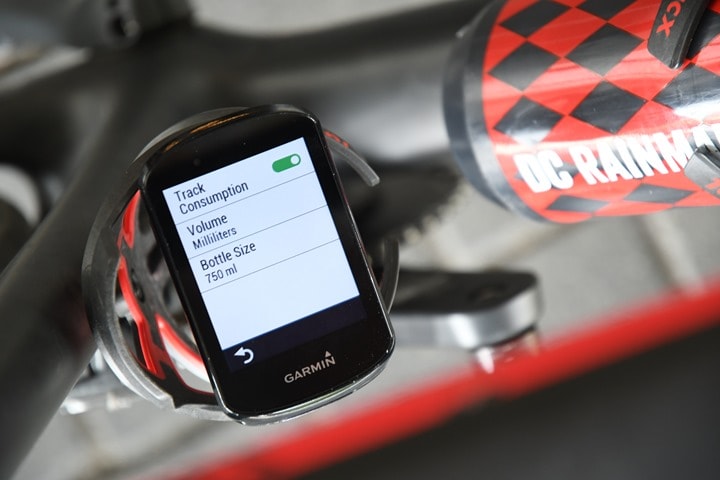
The Edge 830 is a solid little unit, it works well and the touchscreen also works equally as well. It's probably what the Edge 820 should have been, though, hindsight is always 20/20. The new features on the Edge 830, especially ClimbPro, are legit useful. And heck, if nothing else I can now use the altitude and heat acclimation features to justify my slow performance.
The challenge for the Edge 830 isn't that there's anything wrong with it. It's that the Edge 530 is so good, yet $100 less. The only features missing on the Edge 530 are address-specific navigation, round-trip routing (which you can send from Garmin Connect Mobile instantly anyway), and POI routing (which I rarely if ever use). Of course, you don't get the touchscreen on the Edge 530 – though I've never found that a deal-breaker for me. So it's not that I've got anything meaningfully negative to say about the Edge 830 – it's just that Edge 530 is such a good deal (comparatively or otherwise).
What I do think you're seeing with the Edge 830 though is Garmin telling all other mostly new bike computer companies that keep trying to attack the $399 price point, to take a flying leap. It's going to be incredibly hard to compete at not just $399, but now even $299. Wahoo stirred the hornet's nest two years ago with their Wahoo BOLT, and now we're seeing Garmin's development engine really kicking into gear. Whether or not Garmin has any stumbles as production expands though remains to be seen over time.
In the meantime, if you're looking at either of the new units released today, you won't go wrong.
Found This Post Useful? Support The Site!
Hopefully you found this review useful. At the end of the day, I'm an athlete just like you looking for the most detail possible on a new purchase – so my review is written from the standpoint of how I used the device. The reviews generally take a lot of hours to put together, so it's a fair bit of work (and labor of love). As you probably noticed by looking below, I also take time to answer all the questions posted in the comments – and there's quite a bit of detail in there as well.
If you're shopping for the Garmin Edge 830 or any other accessory items, please consider using the affiliate links below! As an Amazon Associate I earn from qualifying purchases. It doesn't cost you anything extra, but your purchases help support this website a lot. Even more, if you use Backcountry.com or Competitive Cyclist with coupon code DCRAINMAKER, first time users save 15% on applicable products!
Here's a few other variants or sibling products that are worth considering:
And finally, here's a handy list of accessories that work well with this unit (and some that I showed in the review). Given the unit pairs with ANT+ & Bluetooth Smart sensors, you can use just about anything though.
And of course – you can always sign-up to be a DCR Supporter! That gets you an ad-free DCR, access to the DCR Quarantine Corner video series packed with behind the scenes tidbits...and it also makes you awesome. And being awesome is what it's all about!
Thanks for reading! And as always, feel free to post comments or questions in the comments section below, I'll be happy to try and answer them as quickly as possible. And lastly, if you felt this review was useful – I always appreciate feedback in the comments below. Thanks!
Found This Post Useful? Support The Site!
Hopefully you found this review useful. At the end of the day, I'm an athlete just like you looking for the most detail possible on a new purchase – so my review is written from the standpoint of how I used the device. The reviews generally take a lot of hours to put together, so it's a fair bit of work (and labor of love). As you probably noticed by looking below, I also take time to answer all the questions posted in the comments – and there's quite a bit of detail in there as well.
If you're shopping for the Garmin Edge 830 or any other accessory items, please consider using the affiliate links below! As an Amazon Associate I earn from qualifying purchases. It doesn't cost you anything extra, but your purchases help support this website a lot. Even more, if you use Backcountry.com or Competitive Cyclist with coupon code DCRAINMAKER, first time users save 15% on applicable products!
Here's a few other variants or sibling products that are worth considering:
And finally, here's a handy list of accessories that work well with this unit (and some that I showed in the review). Given the unit pairs with ANT+ & Bluetooth Smart sensors, you can use just about anything though.
And of course – you can always sign-up to be a DCR Supporter! That gets you an ad-free DCR, access to the DCR Quarantine Corner video series packed with behind the scenes tidbits...and it also makes you awesome. And being awesome is what it's all about!
Thanks for reading! And as always, feel free to post comments or questions in the comments section below, I'll be happy to try and answer them as quickly as possible. And lastly, if you felt this review was useful – I always appreciate feedback in the comments below. Thanks!
What Does the Single Track Sampler Use Enduro Bike
Source: https://www.dcrainmaker.com/2019/04/garmin-edge-830-cycling-gps-in-depth-review.html